Changelog
Beautiful new features and important updates are added to Prepr on a daily basis. This changelog gives you an insight into the most eye-catching releases. Be aware that updates can be rolled out in phases so they may not always be available in all Prepr environments at the same time.
Introducing goals for personalization and A/B testing
December 17th, 2025
Goals allow you to see the overall impact of your personalization and A/B testing experiments on conversions. You can create clear conversion definitions by combining multiple behavioral conditions.
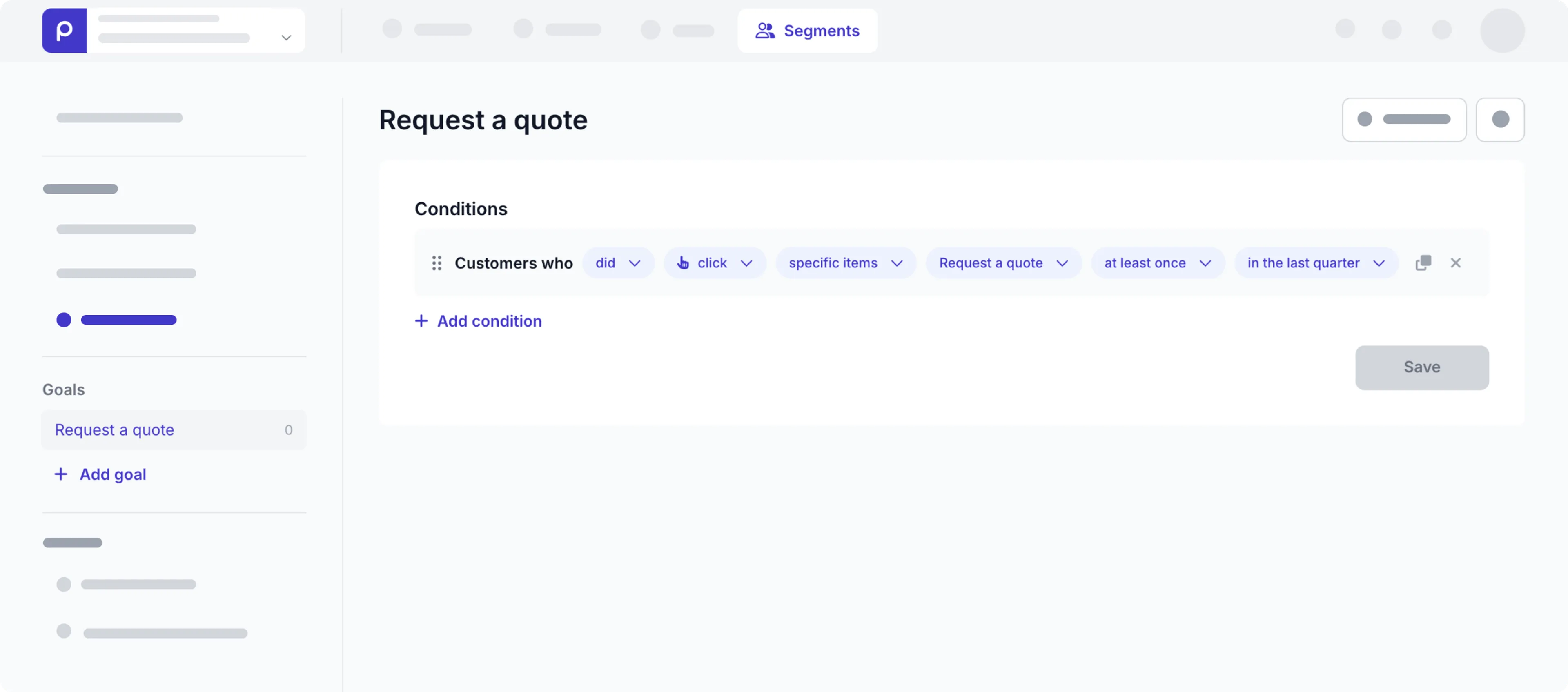
This means you can optimize your website not just for click-through rate (CTR), but for deeper insights. So you can better understand what works for customer experience, boosting engagement and conversion rates.
Check out the Goals setup guide for more details.
New Content tree layout
December 16th, 2025
You can now view your overall structure of content items, by their slug (URL) value, as a visual tree layout. The Content tree layout provides instant, hierarchical context for how an item relates to other content.
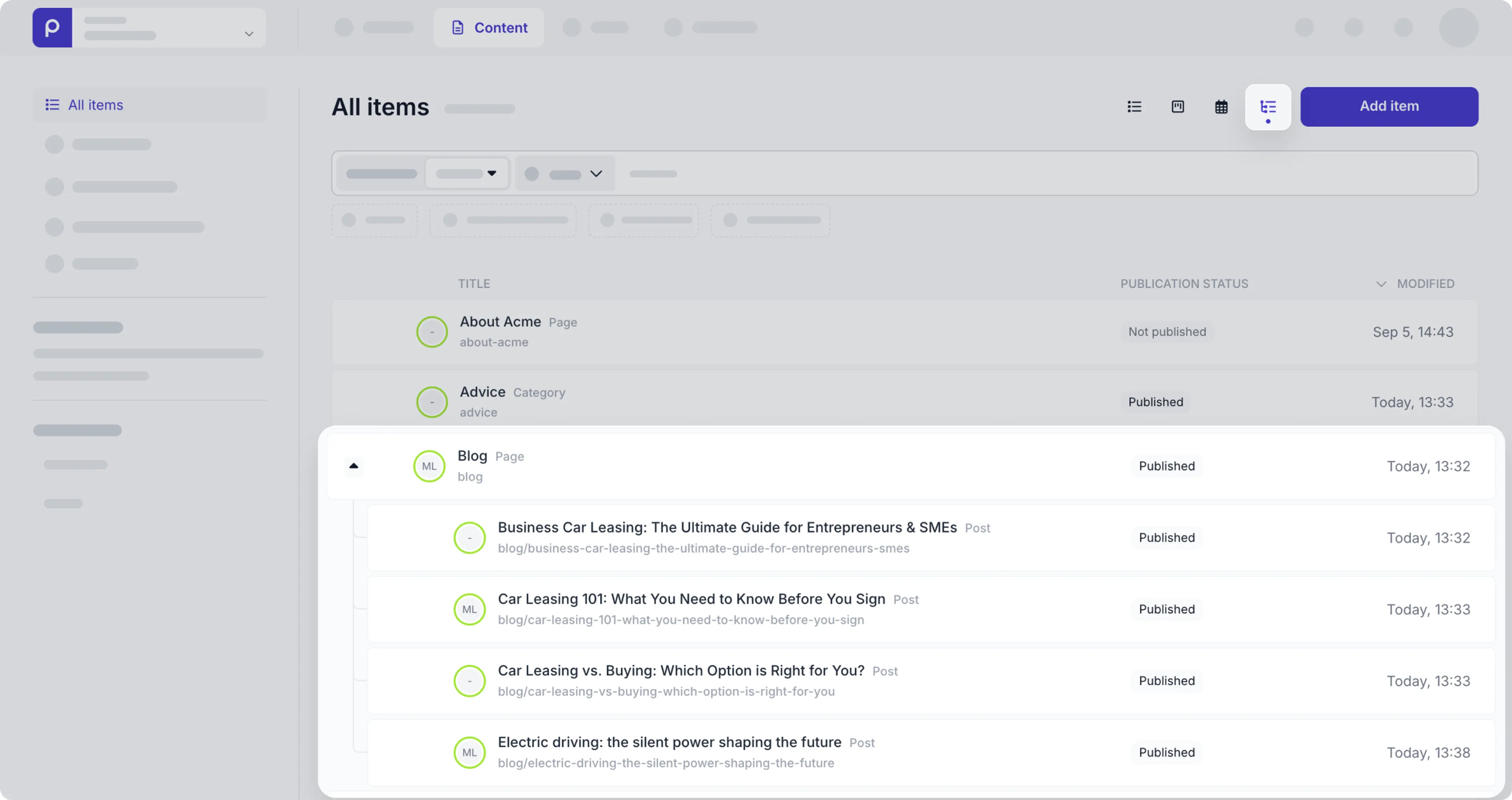
This means improved navigation between content items and less time searching for related items.
The content tree is only meaningful when the slugs are defined consistently for all content items.
For example: The blog overview page is a parent content item and has the slug value blog, while all individual blog articles are child items and have slugs like blog/article-name.
For more details, check out the content tree setup guide.
Generate AI suggestions for personalized variants
December 9th, 2025
When adding personalized content, you can now get AI suggestions for adaptive content based on a customer segment you choose. The auto-generated variant suggestions give you inspiration to quickly create and fine-tune your adaptive content.

The AI generation of adaptive content allows you to automate normally repetitive work of re-writing content for multiple customer segments. This means you can scale your personalization efforts in much less time.
The AI feature is currently not available for referenced content items in the stack.
Check out the Adaptive content guide for more details.
Dynamic initial values for text fields
December 8th, 2025
With dynamic initial values you can set up text fields to prefill based on other field values helping editors speed up content creation. For example, for Post content items, you can define the initial value for the SEO meta description field to be prefilled with the Post excerpt value the editor enters in the content item.

This means simpler data entry and ensures consistency across content items.
Check out the text field settings for more details.
Improved GraphQL caching
November 27th, 2025
We’ve improved our GraphQL API caching mechanism to significantly improve developer experience and workflow reliability when making changes to your Schema.
Now, the GraphQL API automatically refreshes the cache when you make any change to a schema.
This means that your changes are immediately applied when you regenerate your TypeScript types in front-end application.
Check out the GraphQL API caching doc for more details.
Introducing granular permissions to manage content items
November 24th, 2025
With granular content permissions, you can now precisely define a user role to allow users to only create, read, update, delete, manage comments, publish and unpublish content items.
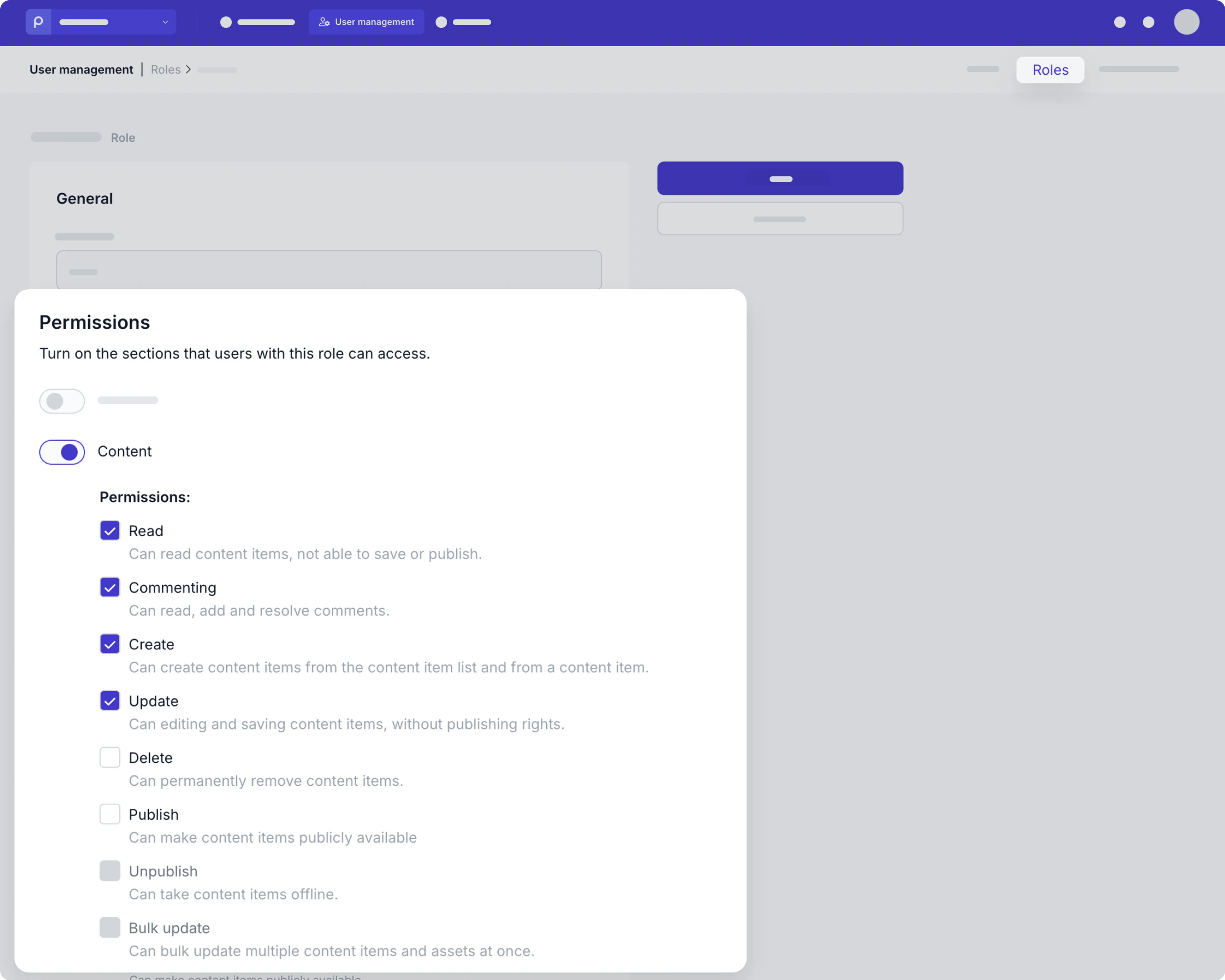
In doing so, you have enhanced security and clearer workflow for every user reducing the risk of accidental errors. Check out the user role guide for more details.
Prepr now available in French
November 24th, 2025
With Prepr now available in French, your users in French-speaking regions or those who prefer French can use Prepr in their native language. You can enable the French UI in the environment settings or each user can set their preferred interface language to French in their account profile.
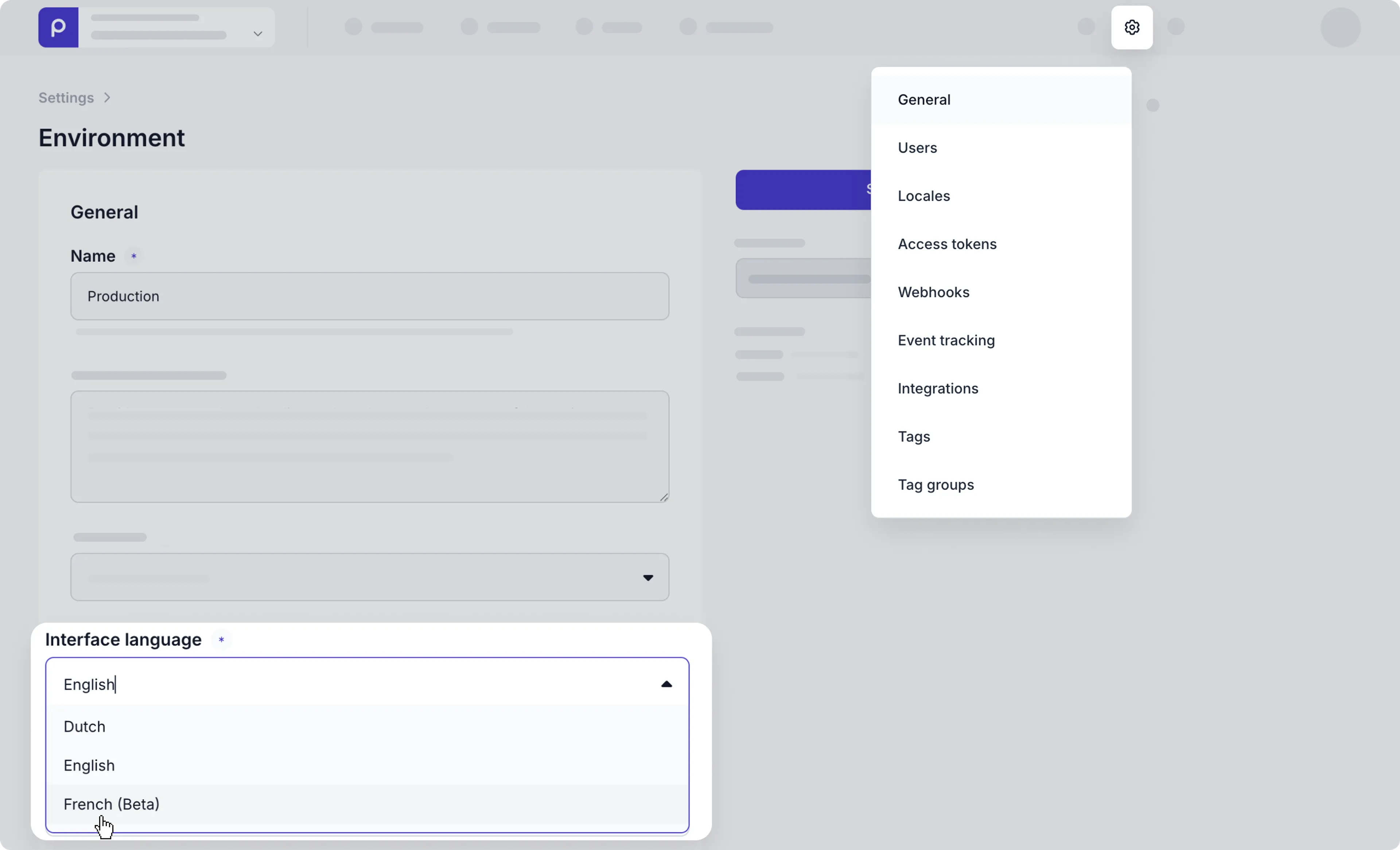
This feature provides a more intuitive and comfortable user experience, leading to greater understanding, and reduced errors for French-speaking users.
For more details, check out the environments settings.
Making slug prefix read-only
November 5th, 2025
We’ve introduced a new option to make the first part of a slug read-only.
When you enable this option in the Slug field settings, editors can only edit the part of the slug after the last /.

With this feature, you enforce consistent slugs ensuring clean and accurate content item URLs and prevent broken links when editors need to update slug values manually.
Check out the Slug field reference for more details.
Conditional visibility by environment
October 23rd, 2025
You can now control field visibility per environment when using a shared schema. This new option lets you choose which environments to show certain fields, ideal for multi-site or multi-brand setups where fields differ slightly between environments.

It makes managing shared schemas much more flexible and keeps your content models clean and relevant across all sites.
Check out the shared schema guide for more details.
New SSO login options
October 23rd, 2025
You can now integrate your preferred identity provider (IdP) to Prepr using one of our new SSO options. In addition to Microsoft Entra ID (formerly Azure Active Directory), you can now set up single sign-on for your Prepr users using Google Workspace, or any identity provider with either the SAML 2.0 or OpenID Connect open standards.

By setting up one of these options, you enhance security and give your users an improved login experience.
Check out the updated SSO guide for more details.
Improved navigation user interface
October 21st, 2025
We’ve improved our navigation with a cleaner and more intuitive interface. The environment selector is now on the left and you’ll see a prominent banner to indicate when you’re logged into a test or development environment. You’ll also find the Settings in a new location on the right when you click the icon.

The updated navigation allows you to work more confidently in Prepr with the clear indication of the environment and type of environment you’re working in.
For more details, check out the environments guide.
Publish nested content items
October 21st, 2025
You now have the option to publish all linked child items in one go when publishing a parent content item.

This prevents broken or incomplete pages and ensures all linked content goes live at the same time. So, you save time and avoid errors by publishing the whole content structure in a single action.
Check out the content management docs for more details.
Introducing filter options for content selection
October 16th, 2025
You can now see filter options in the content item selection modal when you choose to add related content items to your content item.
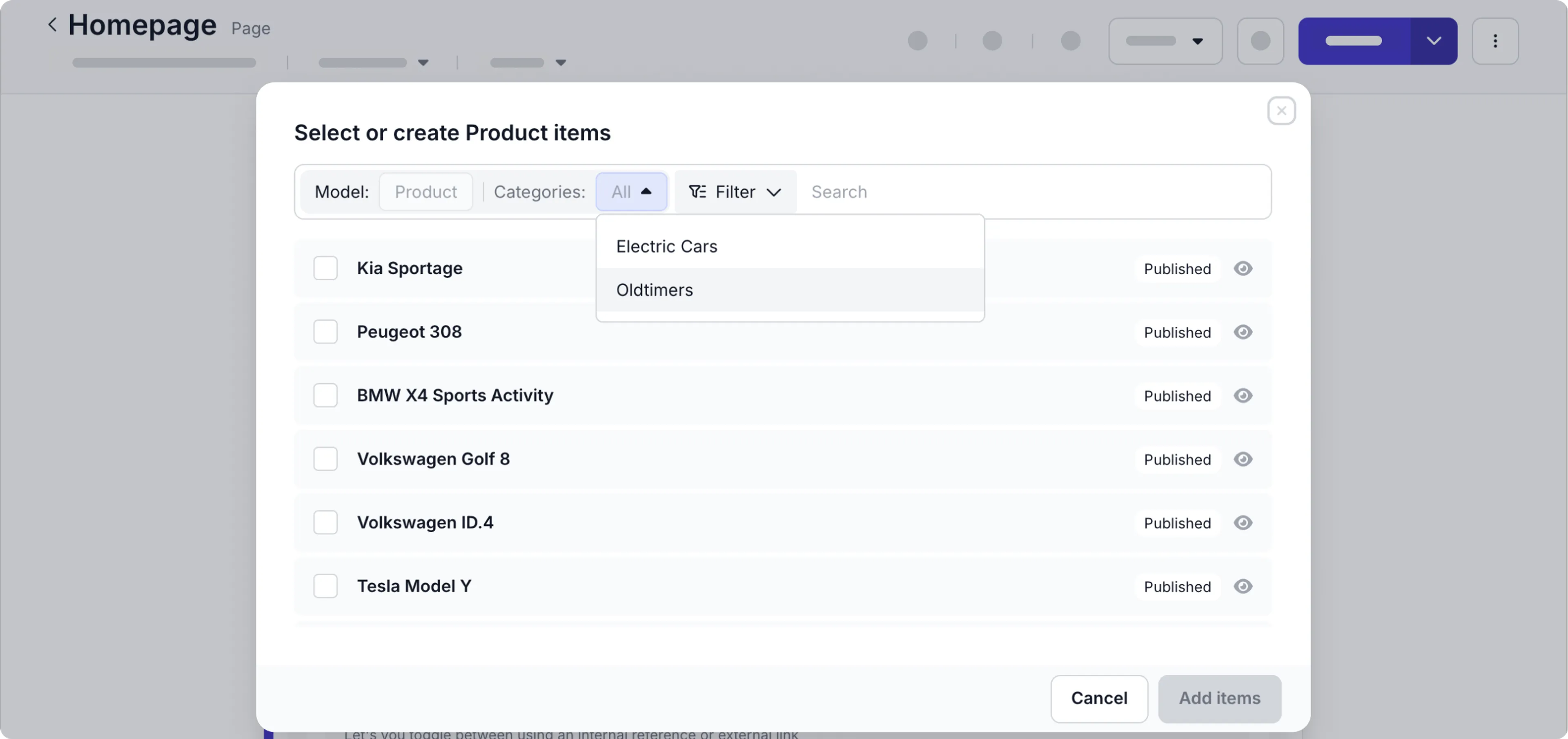
These options allow you to quickly narrow down large lists of content items by key criteria like model, category, or workflow stage. So, you save time and ensure you link related content items more accurately.
Check out the adding content references doc for more details.
Introducing custom workflow stages
October 8th, 2025
We’ve added the ability for you to add custom workflow stages to your Prepr collaboration workflow on the Environment detail page. For example, when you have translation tasks for content items, you could add stages like Translate and Review translation.

This means you can seamlessly align the Prepr workflow with your own content creation process. For more details, check out the environment settings doc.
New GraphQL API version 2025-10-07 is available
October 7th, 2025
Our newest GraphQL API version brings you additional localization support with the following new features:
- A new root query field
DefaultLocalereturns the environment’s default locale. _localein the InterfaceModel_localesin the InterfaceModel
Check out the GraphQL API upgrade guide for more details.
Introducing the Shopify integration
October 2nd, 2025
Our new Shopify integration lets your team easily include products, variants and collections in content items.
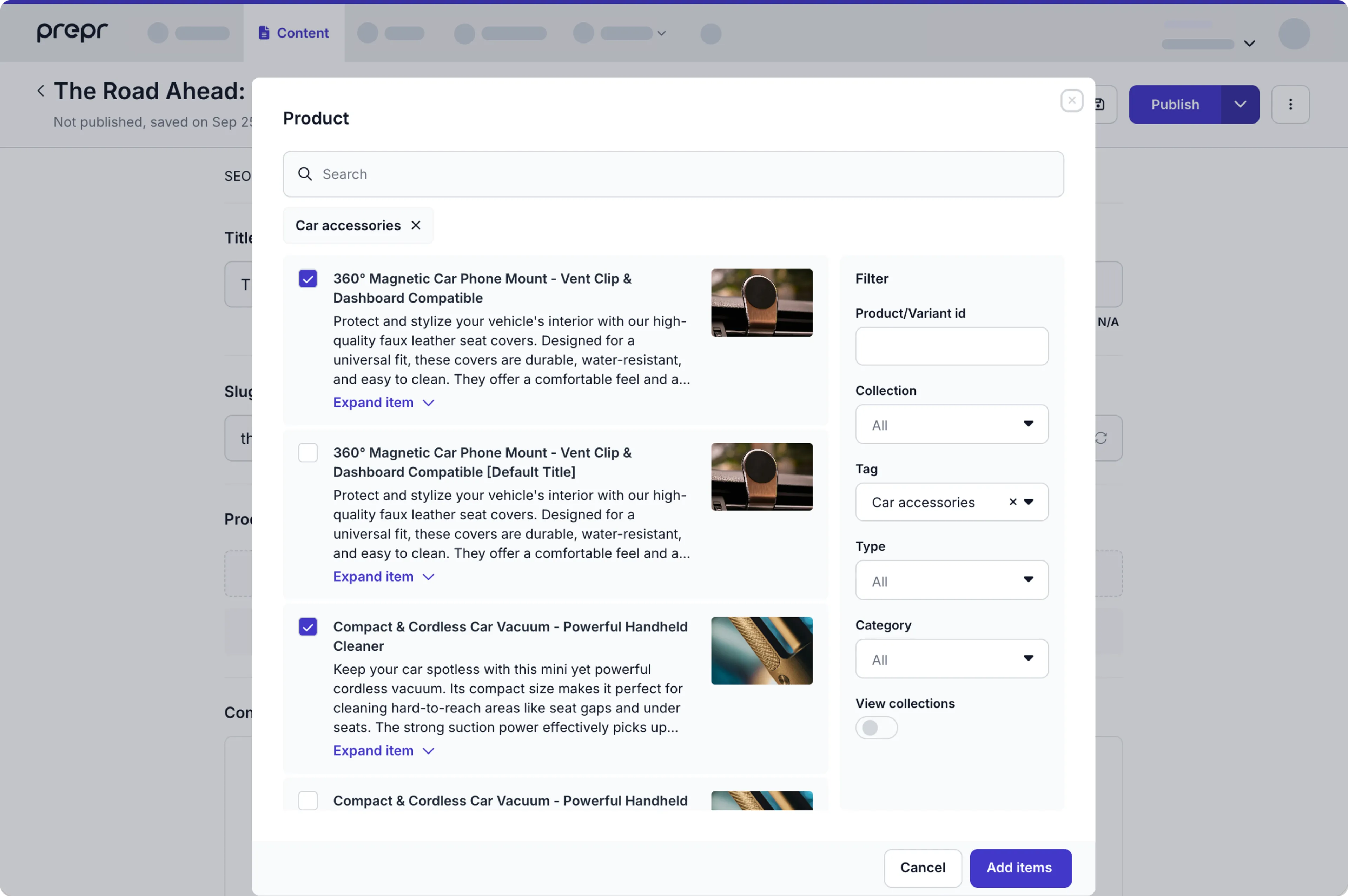
This means your content editors can work more efficiently and error-free by simply choosing the relevant Shopify entries directly in Prepr.
For more details, check out the Shopify integration guide.
Introducing the BigCommerce integration
October 2nd, 2025
Now you can integrate Prepr with BigCommerce to seamlessly add product details to your content.
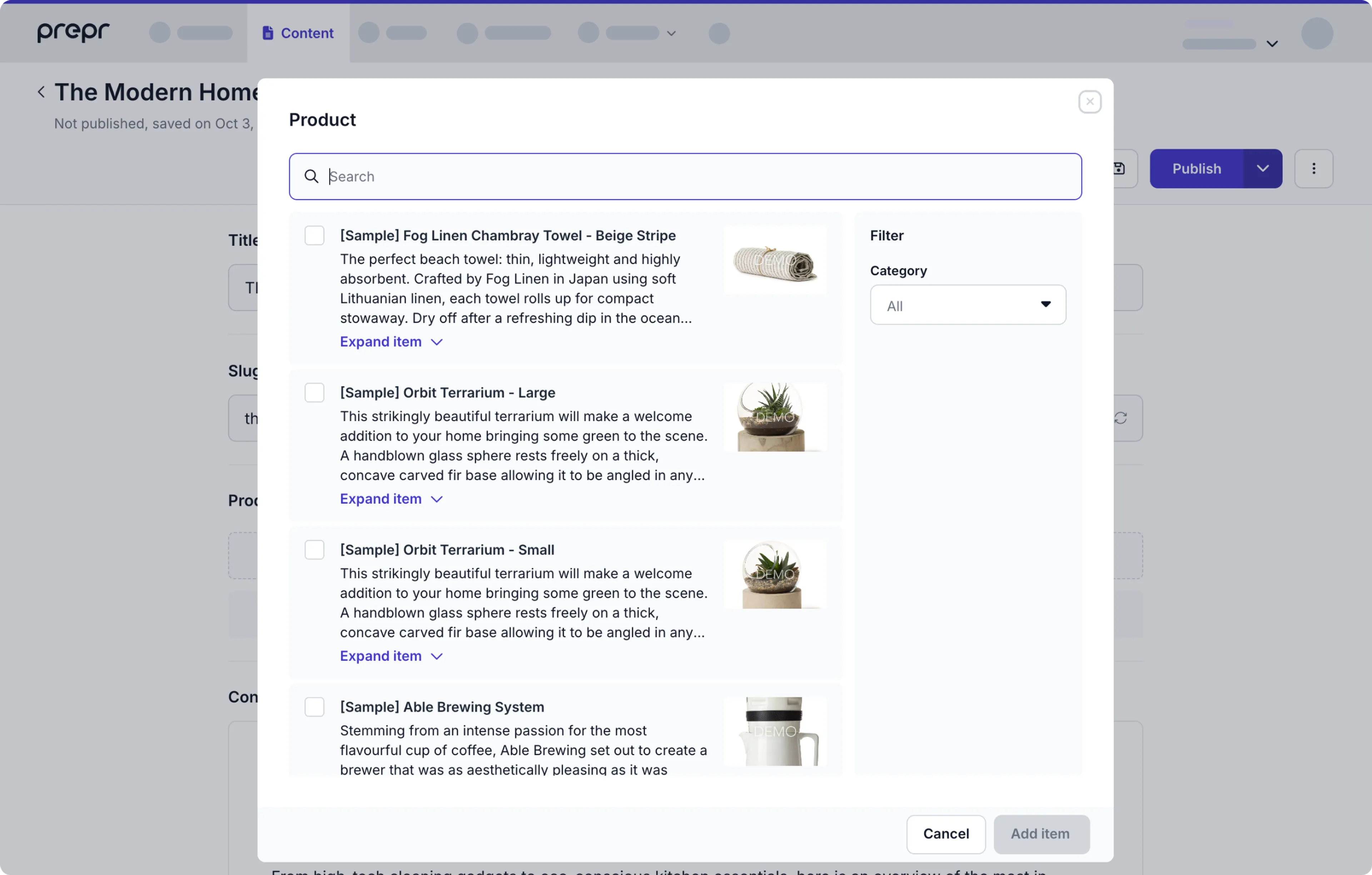
With this integration, your content editors can save time by simply choosing BigCommerce products directly in Prepr.
For more details, check out the BigCommerce integration guide.
Automatically review your content items
October 1st, 2025
Introducing Content check, a new feature that automatically validates the quality of your content and provides AI-powered suggestions for improvements.

In just one click, it checks for missing required fields, broken links and options to boost your SEO. Try out this new tool, part of our continuous efforts to optimize the quality of the content in less time, and let us know your thoughts .
Check out the Reviewing content guide for more details.
Introducing the Snitcher integration
September 15th, 2025
With the new Snitcher integration, you can easily connect Prepr to Snitcher, a B2B website visitor identification platform. This integration allows you to segment website visitors based on their company profile.
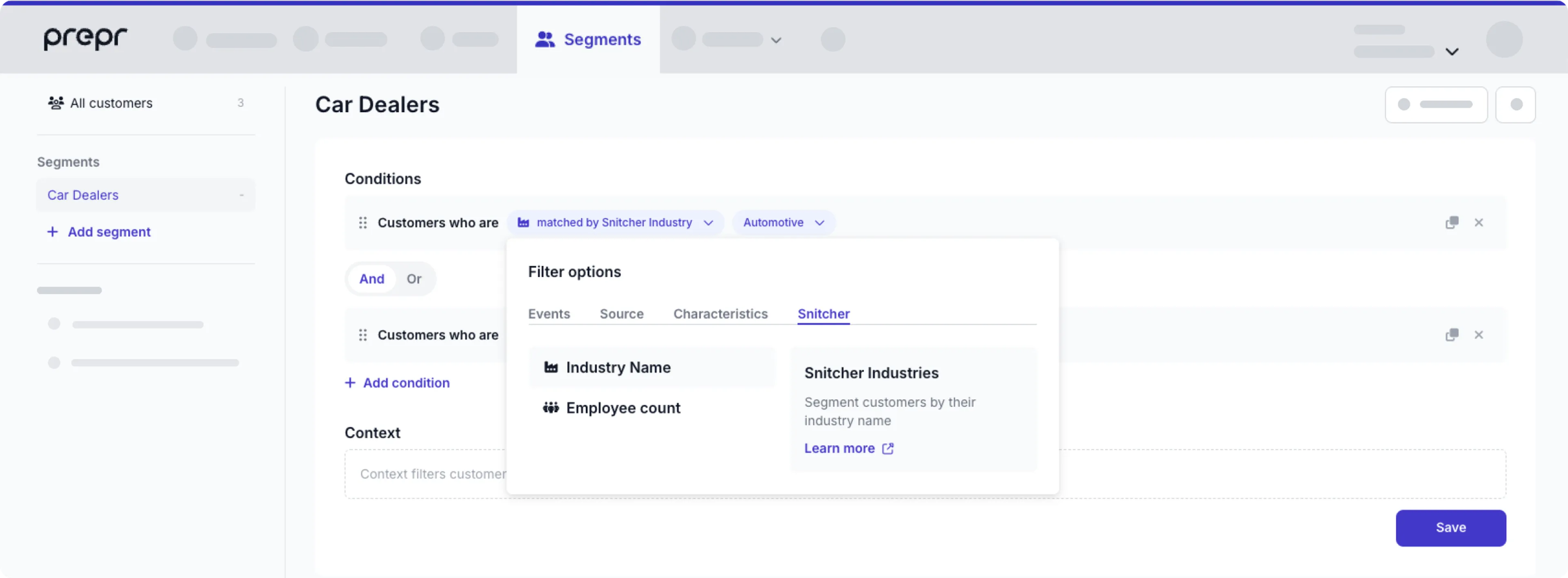
So, you can personalize content for an enhanced user experience for your B2B audience.
Check out the Snitcher integration guide for more details.
New sign-in option to use passkeys
September 10th, 2025
We’ve released a new sign-in option to use passkeys.

This feature gives you an alternative to using the email, password combination and 2FA.
This means you can log in securely and conveniently without needing to manually manage passwords or additional authentication steps.
For more details, check out the account profile settings.
New option to hide models from Add item list
September 3rd, 2025
You can now simplify the content creation experience by reducing the list of models content editors need to select from. To make this possible, choose which models to hide from the selection list in the Add item modal. For example: Hide models for child content items like an Author or Category which are usually created when editing an Article.

By disabling the visibility of certain models, you ensure content editors only see what’s relevant to them.
Check out the Model settings for more details.
Organize your segments into folders
August 28th, 2025
You can now group your segments into folders, making it easier to manage and navigate when working with many customer profiles. Instead of scrolling through a long alphabetical list, related segments can be organized together in a structured way.

This update gives you a simple way to stay organized and find the right segment faster.
For more details, check out the Managing segments guide.
Matching HubSpot contacts to Prepr customer profiles
August 25th, 2025
Prepr now automatically matches your HubSpot contacts to existing Prepr customer profiles, putting them in their matching HubSpot segments and updating their company name and email address. This way, you ensure your HubSpot customer profiles are always accurate and up to date.

With this release, you can create personalized, data-driven content even more precisely.
Check out the HubSpot integration guide for more details.
Algolia Auto sync option
August 20th, 2025
With the new Algolia Auto sync option you can choose to disable automatic synchronization of content to Algolia directly in Prepr.

This gives you more control and helps you prevent issues with the web app search functionality resulting from bulk updates, for example. In other words, ensure a stable search experience for your users.
Check out the Algolia integration guide for more details.
A/B testing article headlines
July 30th, 2025
You can now run experiments for article headlines by adding an A/B test directly to a header or title Text field. For example, to test headlines in a list of recommended articles on the home page. Now you can measure which headlines encourage readers to open the article they want to read.
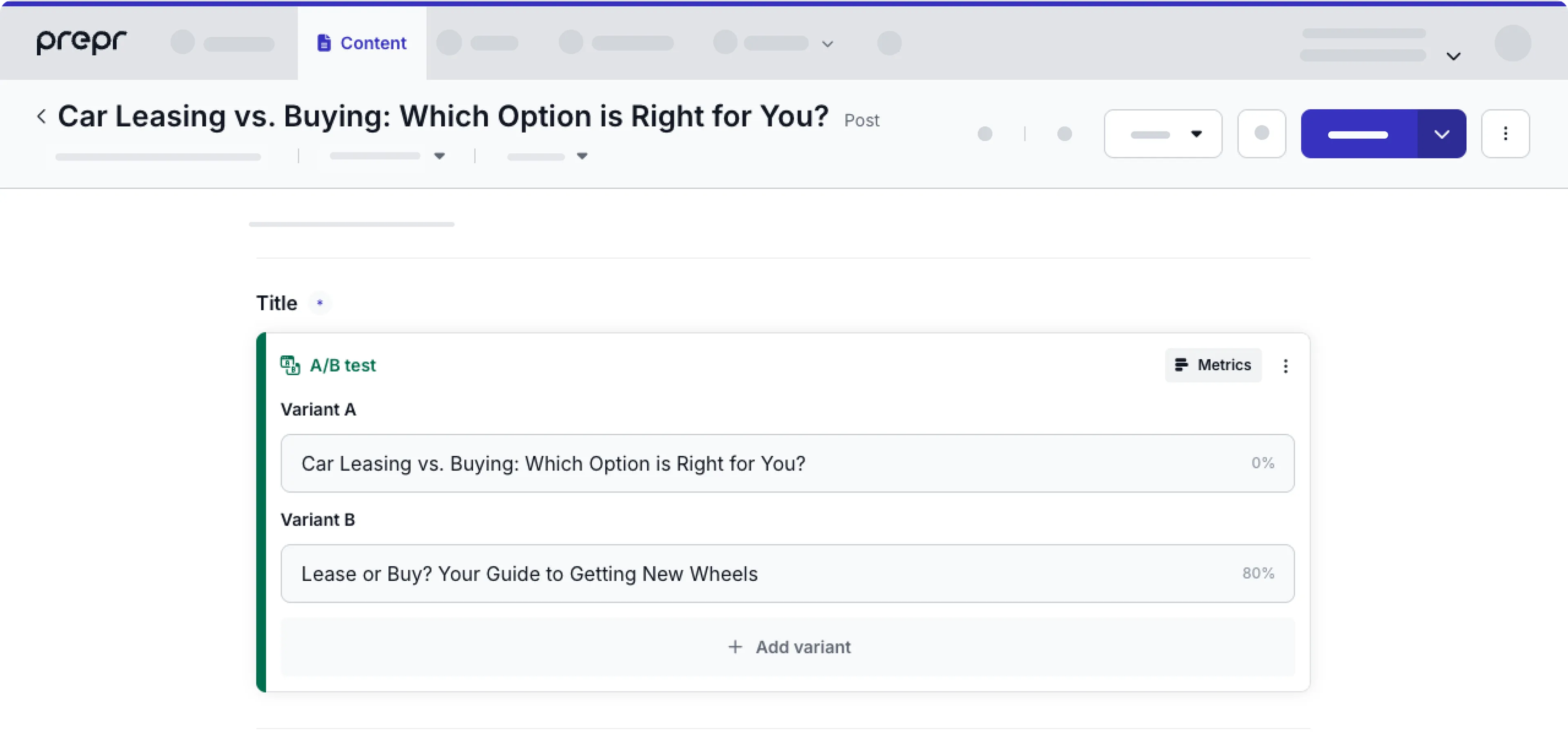
Optimize performance with surgical precision, driving higher engagement and conversion rates.
To enable A/B testing on a text field check out the Text field settings.
New Prepr Next.js package version is available
July 22nd, 2025
We’re happy to bring you a new and improved version of the Prepr Next.js package, a toolkit to streamline your personalization and A/B testing implementation for your Next.js front end. We’ve redesigned the Preview Bar into a less intrusive floating toolbar, giving content editors a cleaner, distraction-free preview experience.
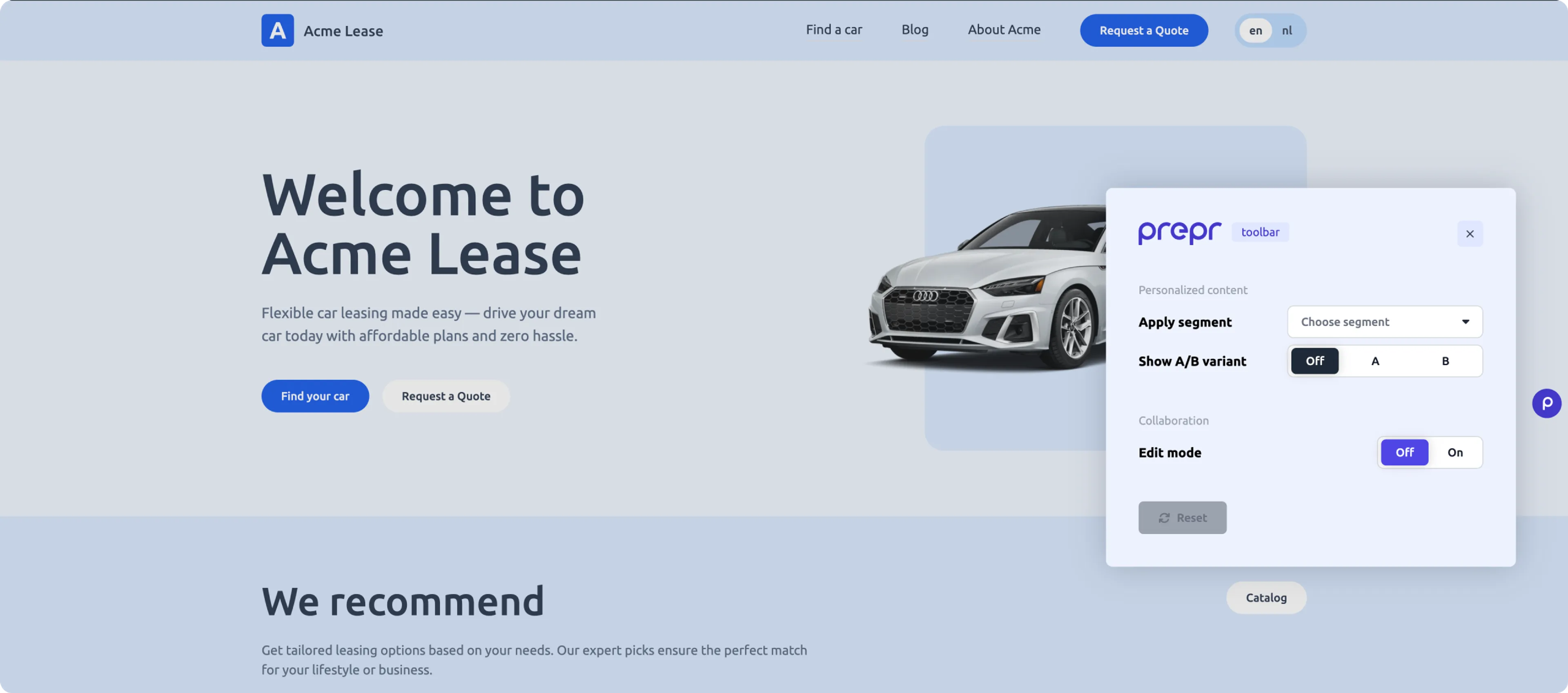
In addition to previewing different A/B test variants and personalized experiences, content editors can now enable Edit mode to highlight any element in the preview page. When enabled, they can then simply hover over elements to reveal links that open the corresponding item directly in Prepr for quick updates.
Check out the Prepr Next.js package guide for more details.
Improved handling of conditional required fields
July 18th, 2025
We’ve released an important update to ignore the required field validation when a field is conditionally hidden. Previously, if a required field was hidden due to conditional logic, it would still prevent a content item from being published. This often led users to mark fields as non-required simply to avoid validation errors during publishing.
With today’s update, a required field is only enforced when it is visible to the content editor. If the field is hidden due to a conditional setting, it’ll be treated as not required in the API schema. However, fields that are always visible remain required both in the editor and the API.

This improvement is enabled by default for new customers, while existing environments can activate the feature manually in the Environment settings page.
Check out the environment settings for more details.
Introducing content item views
July 16th, 2025
With the new content item views, we’re introducing a cleaner interface to manage content visibility. This new feature allows you to create, organize, and access your own tailored views.
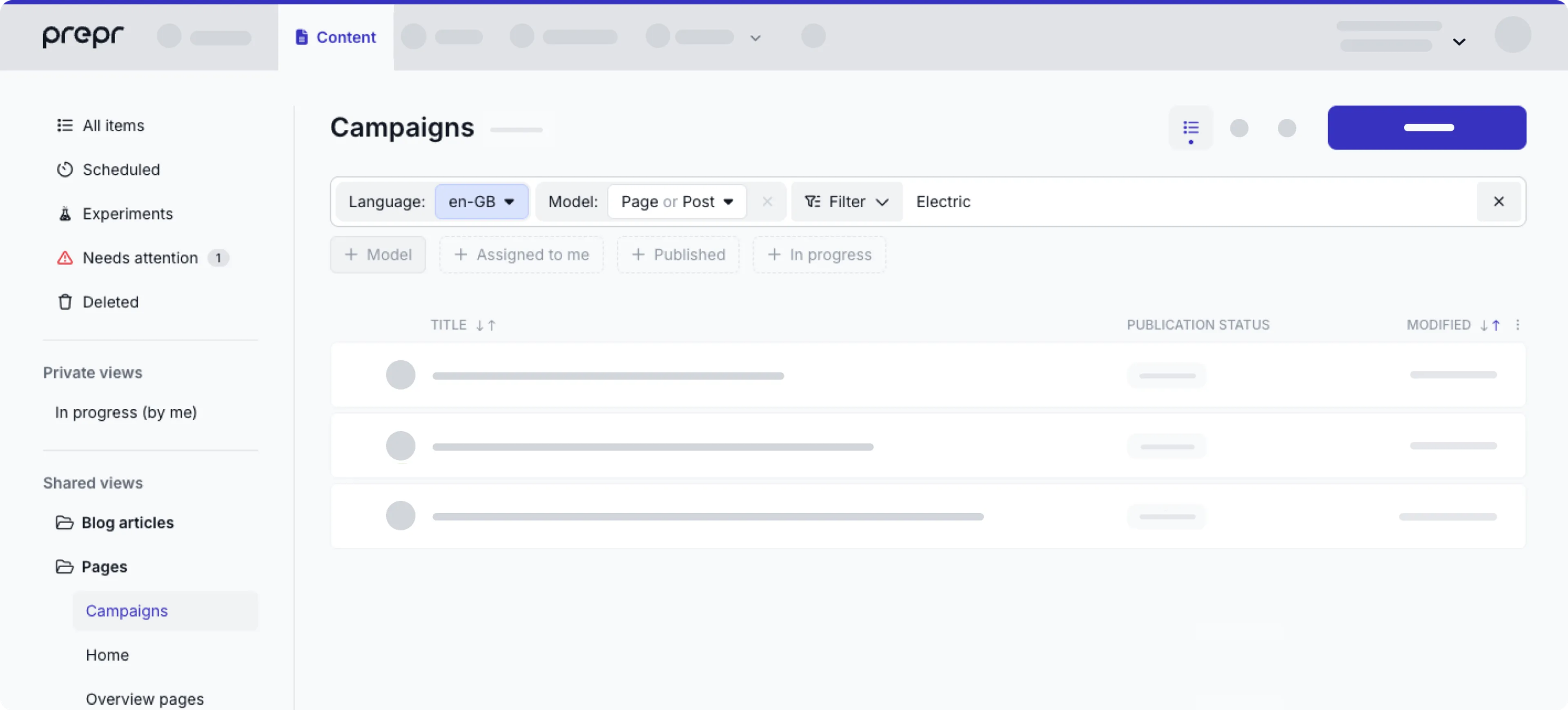
The new content item views replace how you previously used saved filters for content items. You can save time by creating views that are most relevant for you, while your team can collaborate more effectively with shared and role-based views.
Check out the managing content doc for more details.
Introducing the Needs attention overview
July 16th, 2025
To enhance the reliability and quality of stored content, we’ve added a content quality checker to find content items with broken links or content items that could not be published. You can find the list of these content items in the new Needs attention view.

These quality indicators help prevent broken user experiences on live websites and empower content teams to quickly identify and resolve issues before publication.
Check out the managing content doc for more details.
Recovering deleted content items
July 16th, 2025
With the new Deleted view, you can now quickly find and restore deleted items with just a few clicks, for example, if you deleted an item accidentally.

Check out the managing content doc for more details.
Two-factor authentication (2FA) required for Owners and Admins
July 1st, 2025
To strengthen account security, 2FA is required for all users with an Owner or Admin role in a paid Prepr organization as of July 1, 2025. If 2FA is not enabled, users will be prompted to set it up before accessing Prepr. SSO users are exempt from this requirement.
Check out the Activating two-factor authentication guide for more details.
New Identify event to store identity provider user IDs
June 25th, 2025
The new Identify event stores a user’s unique ID from your Identity Provider directly in their matching customer profile in Prepr.
prepr('event', 'Identify', 'external-profile-ID');This event allows you to accurately link customer data when they log in to your web app giving you more precise data analysis.
For more details, check out the recording events doc.
Introducing the Pipedrive integration
June 24th, 2025
With the new Pipedrive integration, you can embed Pipedrive forms directly into your content items.
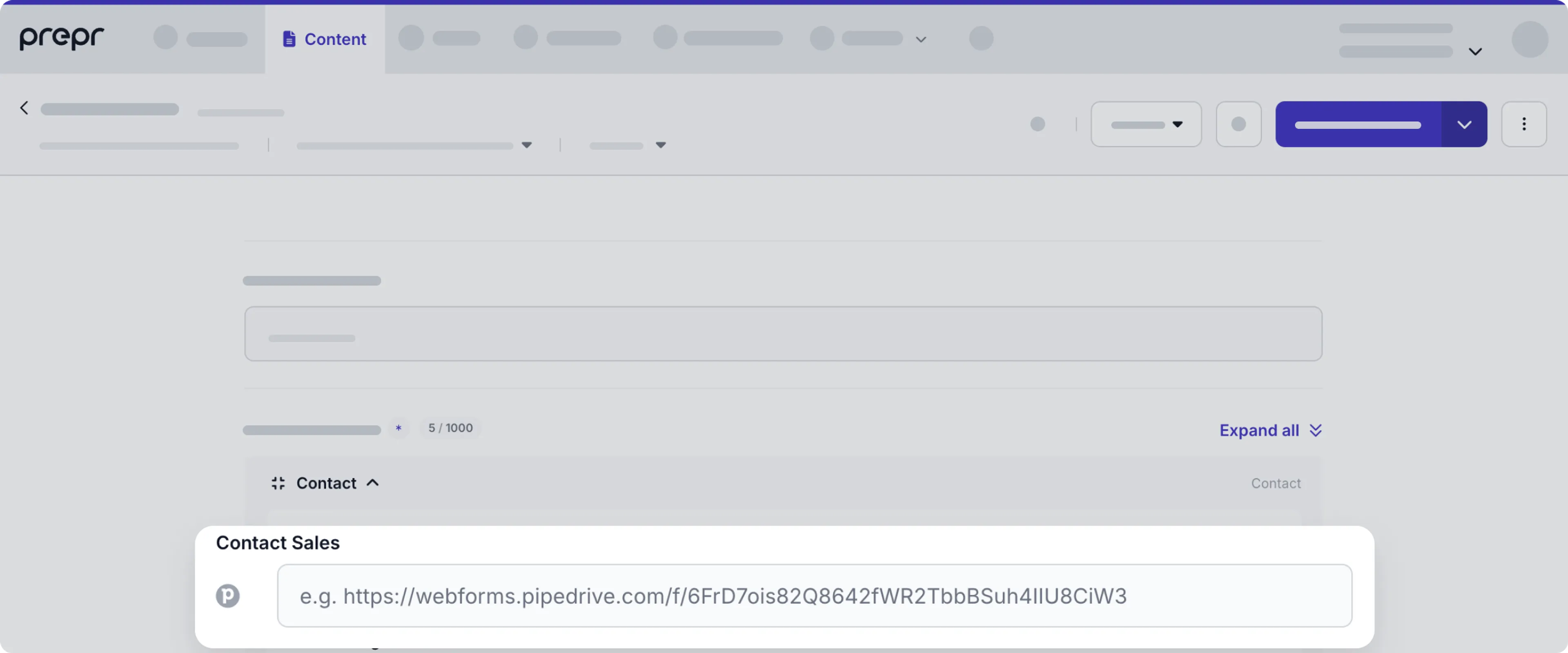
This means you keep your content and related Pipedrive forms in one place. Just enter the matching Pipedrive form URL to link the form you need.
Check out the Pipedrive integration doc for more details.
New PATCH mutation endpoint in public beta
June 24th, 2025
We’ve introduced a new PATCH endpoint for content items in the Mutation API, allowing you to update just a single field in an
existing item instead of replacing the whole object. This aligns with HTTP PATCH best practices for partial updates and efficiency.
Plus, thanks to refined metadata handling, this endpoint won’t trigger the changed_on timestamp — so batch updates no longer
clutter the editor interface.
For more details, check out the Mutation API doc.
Introducing the Dealfront (Leadfeeder) integration
June 18th, 2025
We’re excited to introduce a new B2B integration in Prepr with Dealfront. This powerful new integration lets you segment website visitors based on their industry and company size.
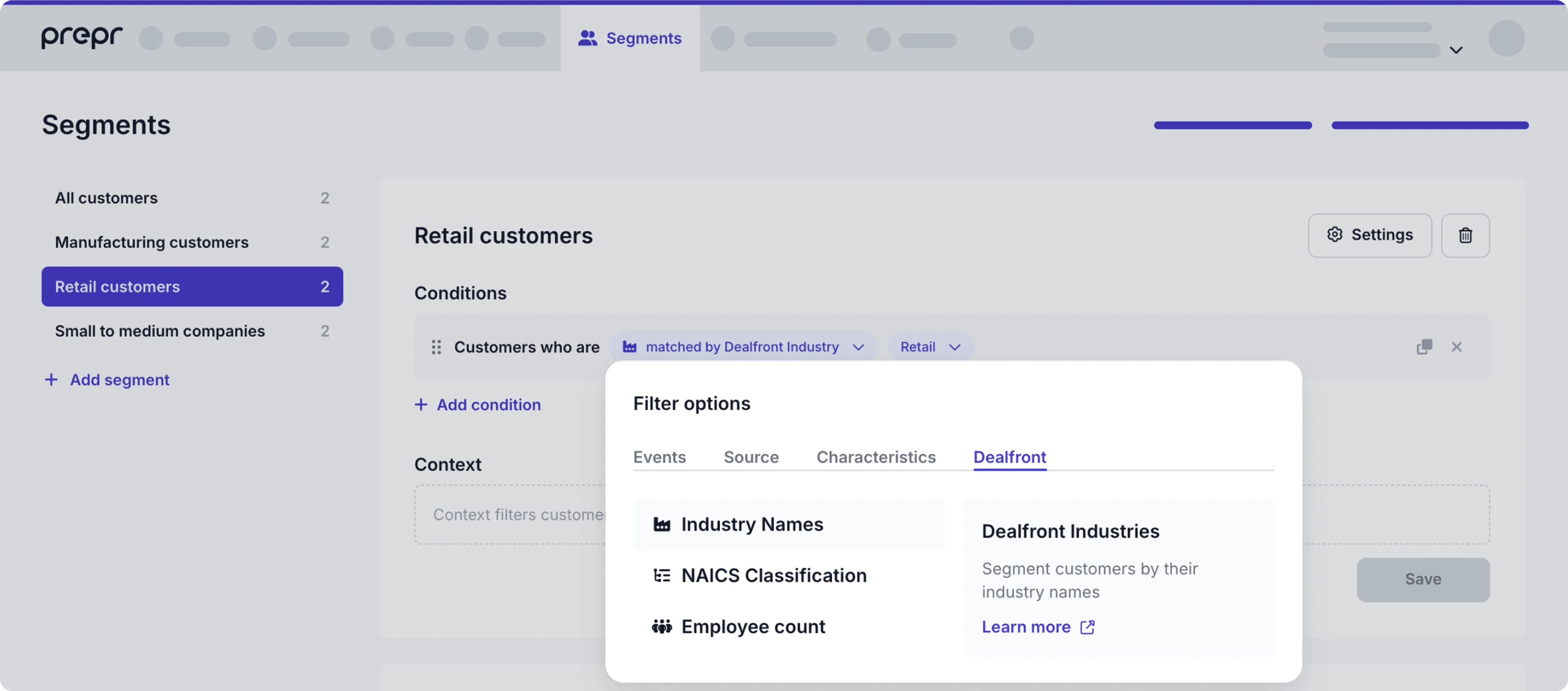
This allows you to personalize content for an enhanced user experience for your B2B audience.
For more details, check out the Dealfront integration guide.
New enumeration JSON editor
June 11th, 2025
We’ve introduced a new option to add or edit enumeration values using a JSON editor.

This new option enables you to quickly access and copy the data structure and add your own updated JSON. This saves time, especially when you need to add or edit an enumeration with an large list of values.
Check out the enumerations doc for more details.
Personalization across all Stack fields
June 3rd, 2025
Previously, you could add personalization and A/B test content only to a stack field directly included in the model. We’ve enhanced the Stack field to allow personalization and A/B test content at any level in the content structure. These include stack fields in components and within dynamic content fields. For example: In a CTA button component to only personalize the button instead of the whole section of the content item where it’s used.
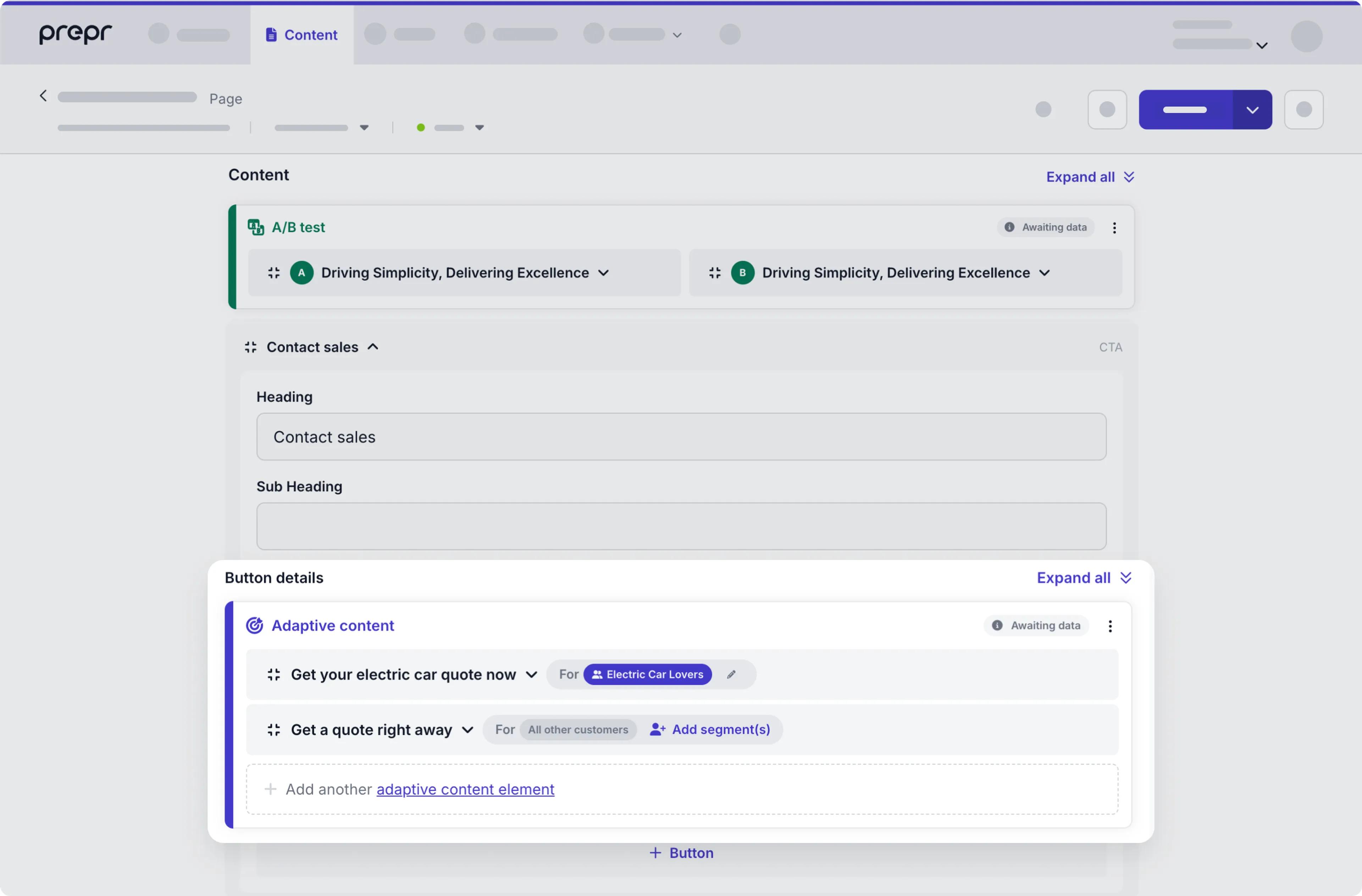
This feature gives you more flexibility for adaptive content in the web app and an improved user experience.
To use this feature, make sure to use the newest GraphQL API version 2025-05-27.
Dynamic content in components
June 3rd, 2025
Previously, you could only add a dynamic content field to a model. It’s now possible to add a Dynamic content field to a component to add rich content sections to your section-based pages. For example, to publish a guide with your chosen styling.
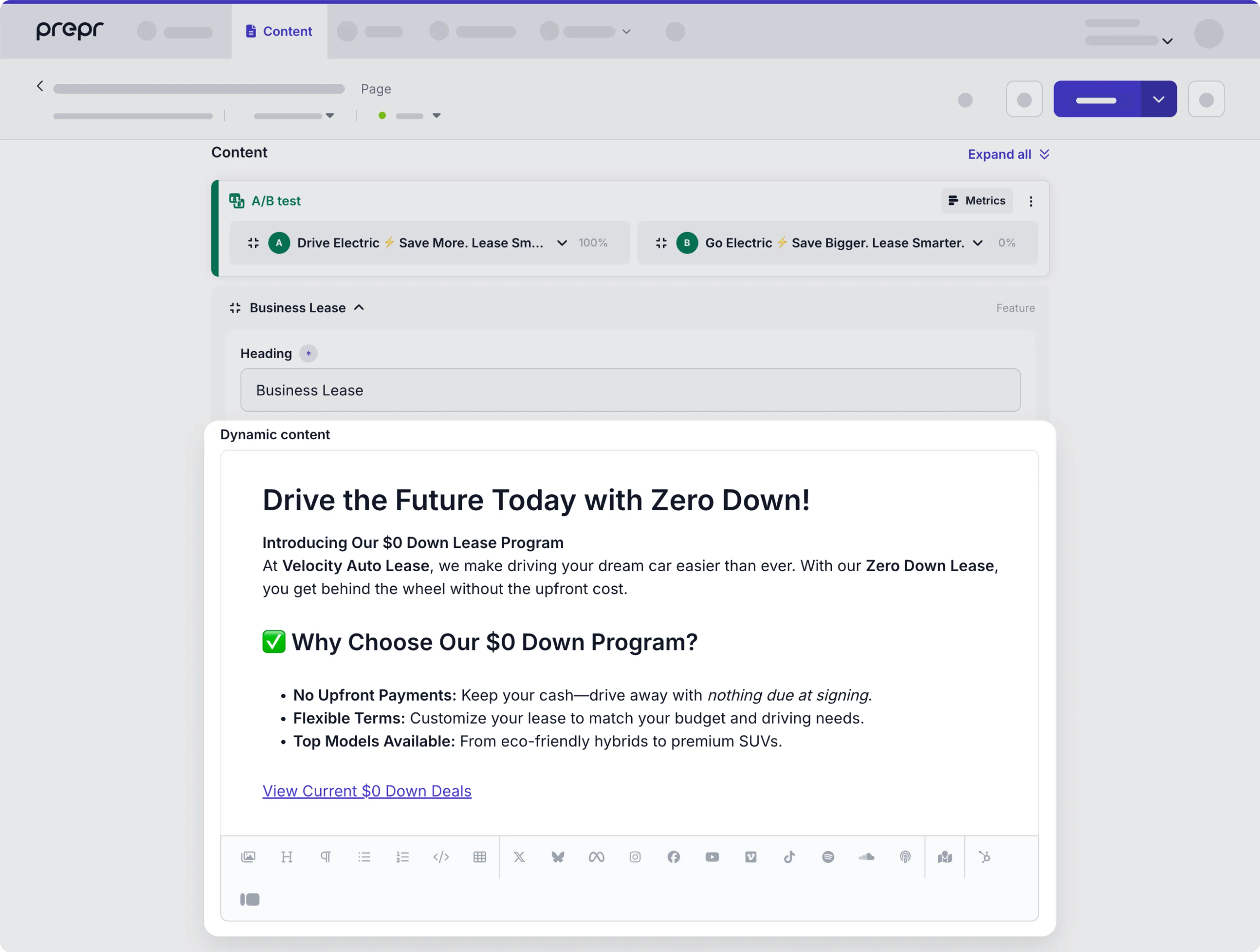
This feature allows more flexibility when editing content and more dynamic content delivery in the web app.
To use this feature, make sure to use the newest GraphQL API version 2025-05-27.
New GraphQL API version 2025-05-27 is available
May 27th, 2025
Our newest GraphQL API version brings you more flexibility when creating a schema and developing an adaptive web app with the following new features:
- Support for A/B tests and adaptive content elements within Stack fields in components, allowing for more dynamic content delivery and an improved user experience.
- The Dynamic Content Editor field is now available in components, enabling you to create engaging and personalized content easily.
- We’ve introduced the Tags field in components, providing a flexible way to categorize and manage your content more effectively.
- You can now access a default query to retrieve the locales available in your environment, making it easier for you to implement localization in your front end.
- We’ve enhanced sorting on
stringfields to be case-insensitive, ensuring a more intuitive and user-friendly experience.
Check out the GraphQL API upgrade guide for more details.
Setting an initial value for Stack field
May 13th, 2025
It’s now possible to add elements such as specific content items and components to the initial value of a Stack field. This release also allows you to add an initial value to a Content reference field. With this feature, you get a suggested outline when you create more complex content items such as pages with many possible elements.
For example, when you create a new Page content item, you could get a preselected Hero component, Feature component and a Call to action item.

This allows you to create consistent and structured content, and saves you time and reduces errors.
Check out the Stack field setup for the setup details.
Improved content item filtering
May 13th, 2025
We’ve added the Unpublished changes option to the Publication status filter. This addition joins the existing filters for Published, Scheduled, and Not published items, giving you better control and visibility over draft updates. You can use this filter option in the list, calendar, and kanban views to streamline your content management workflow.
Check out the content management doc for more details.
Support for dates and location fields in Algolia and Typesense integrations
May 8th, 2025
The Prepr search integrations with Algolia and Typesense now support date fields and location fields. This update enables more flexible filtering options, such as showing nearby events or sorting content based on dates, making the integration more useful for time-based and location-based use cases.
Check out the Algolia docs and Typesense docs for setting up the integration with dates and location fields.
Two-factor authentication (2FA) required for Owners and Admins starting July 1, 2025
May 8th, 2025
To strengthen account security, 2FA will be required for all users with an Owner or Admin role in a paid Prepr organization as of July 1, 2025.
If 2FA is not enabled by that date, users will be prompted to set it up before accessing Prepr.
SSO users are exempt from this requirement.
Check out the Activating two-factor authentication guide for more details.
Improved document naming and URL structure
May 6th, 2025
We’re pleased to let you know that we’ve improved how document files are named and how their URLs are set in Prepr CMS.
Now when you upload new documents (pdf, zip, docx and xlsx), they retain their original file name. The URL to download a document includes a cleaner prefix after the hostname, providing a more structured and consistent format for better organization and readability.
Example
Previous URL structure: https://example.files.prepr.io/695a4d1eiaom-sustainability-report.pdf
New URL structure: https://example.files.prepr.io/695a4d1eiaom/sustainability-report.pdf
These changes make it easier for you to manage these assets, better visibility, and they align with SEO best practices.
This update only applies to newly uploaded documents. Existing documents will retain their current file names and URLs.
Check out the Editing assets doc for more details on documents fields.
Sending events to Google Tag Manager
May 1st, 2025
It’s now possible to send experiment-related Prepr events to Google Tag Manager (GTM). This is a seamless integration of Prepr’s experiment data with your existing GTM setup, giving you centralized tracking.
To enable the integration to GTM, simply update the Prepr Tracking Code in your front end to include the googleTagManager destination flag. Check out the tracking setup doc for more details.
Introducing content item calendar view
May 1st, 2025
With the content item calendar view, you can now easily manage your scheduled content directly within a calendar interface. With this clear, visual overview of all your scheduled items, it’s now easier to manage timing and avoid overlaps saving time and keeping you organized.

For more details, check out the content management doc
Publication status in content item list
April 18th, 2025
We’ve updated the content item list display for content reference fields, stack fields and their corresponding search dialogs to display the publication status instead of the workflow stage. Now when you view these fields or add a content item for a content reference or stack field, you can easily see which of the listed content items are published or not.
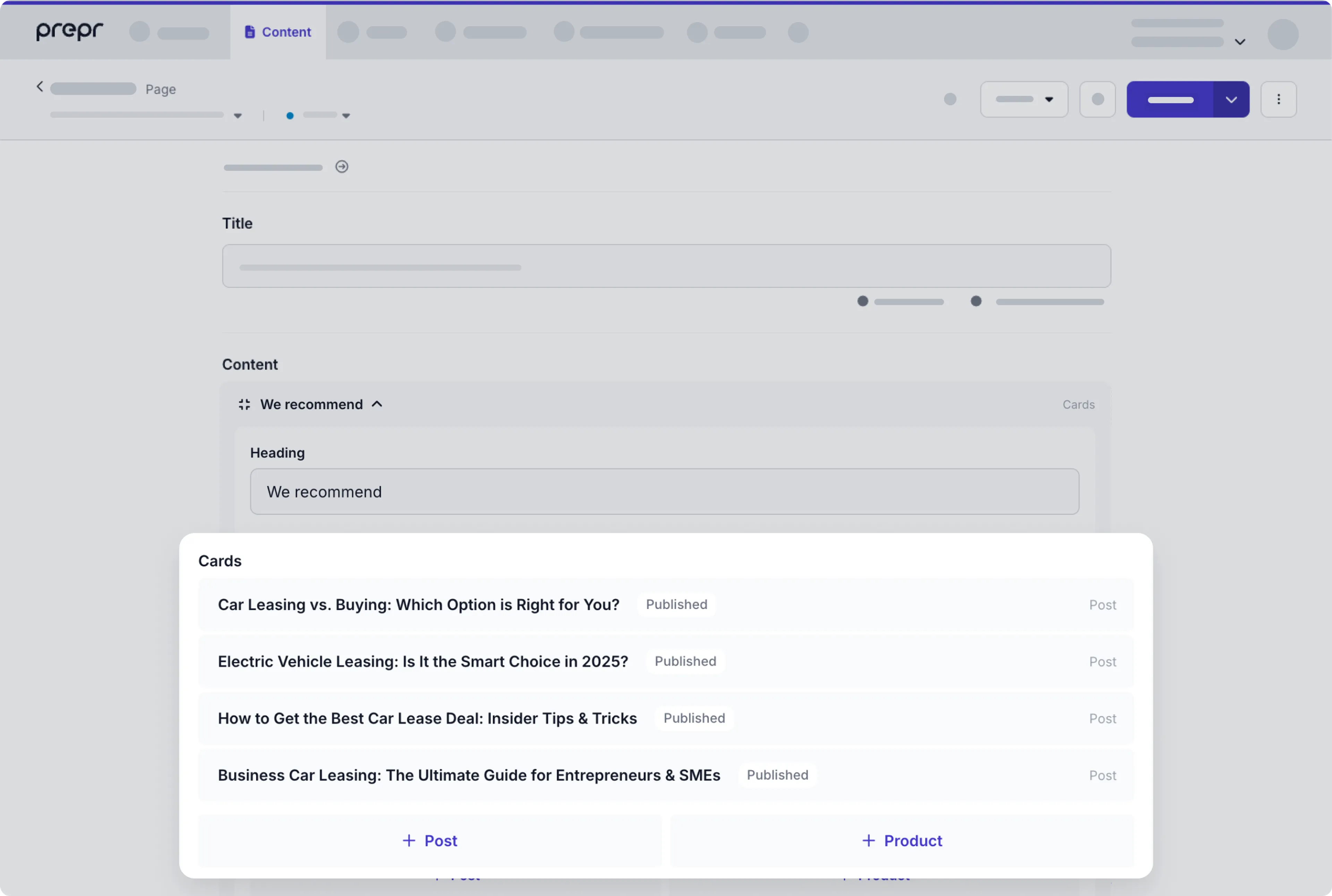
Example of blog posts listed in Content stack field
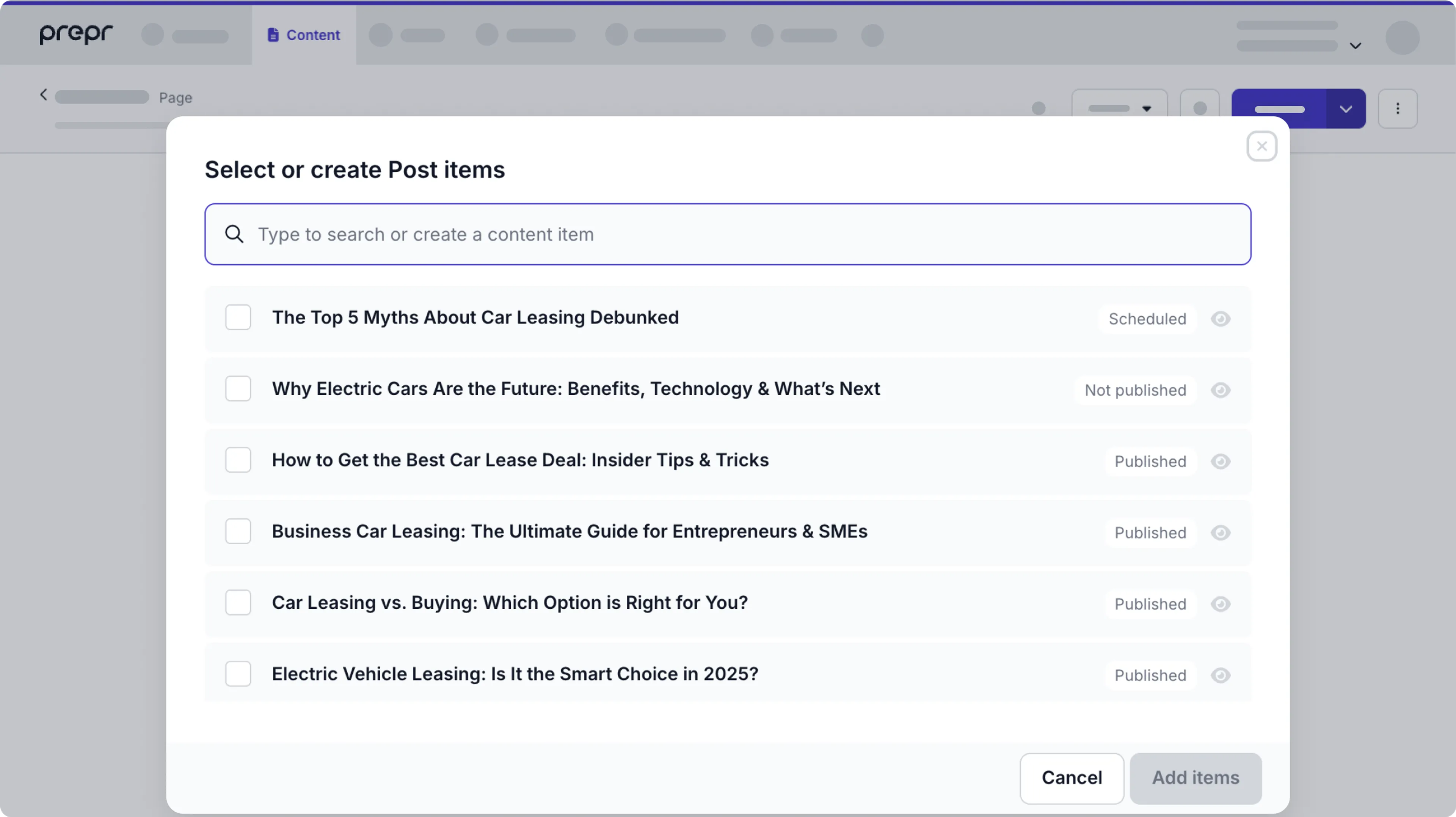
Example of Post items search dialog
This change helps reduce confusion, and gives you clearer and more actionable information. Check out the content management docs for more details on the publication status.
Setting a personal default locale
April 17th, 2025
Users can now set a personal default locale that overrides the environment’s default. This is especially useful for international teams, giving editors a more tailored experience when working with multilingual content.

Check out the localizing content docs for more details.
New slug option to remove trailing slash automatically
April 11th, 2025
We’ve added a new option to automatically remove trailing slashes from slugs when the field loses focus. A trailing slash typically indicates a directory in URLs, but inconsistent use can lead to messy or duplicate links. With this update, Prepr ensures cleaner and more consistent URLs by trimming trailing slashes, helping you maintain a more structured and SEO-friendly content setup.
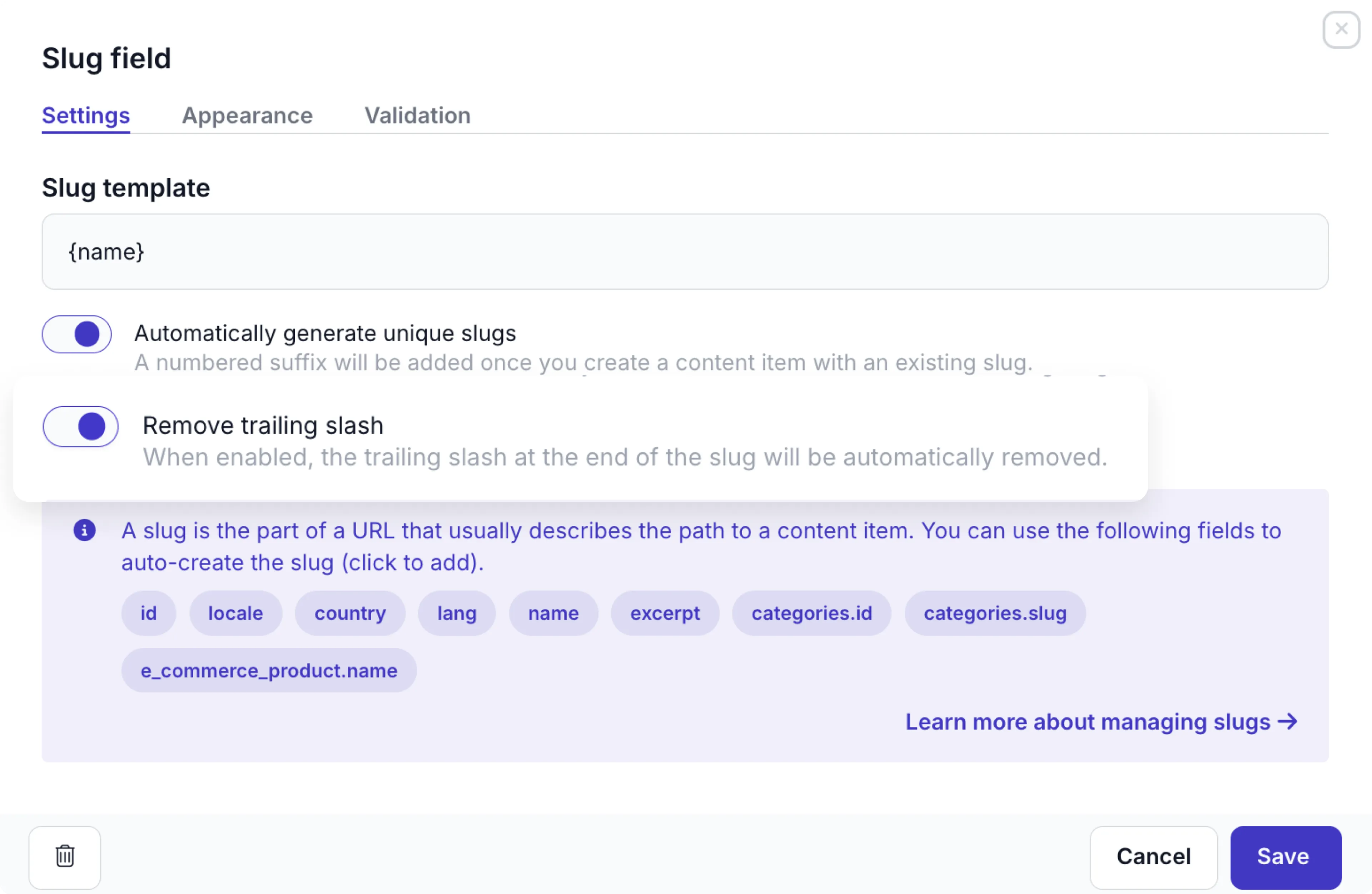
Check out the slug field settings for more details.
Introducing the new Form field
April 8th, 2025
With the new Form field, you can now easily add HubSpot and Typeform forms directly in your content items.

With this feature, you keep your content and related embedded forms all in one place. Just click to search for the form you need. It’s that simple.
Check out the integration docs for HubSpot and the Typeform to learn how to use the Form field.
Advanced filtering on content items
April 8th, 2025
We bring you more advanced filtering on content items to help you find exactly the content items you need. Until now, you could only filter by one value for each of the listed filter options, apart from Tags. With this update you can filter by multiple values, for example when you want to view a list of both Page and Post content items, you can simply choose both values when you filter by the Model option.
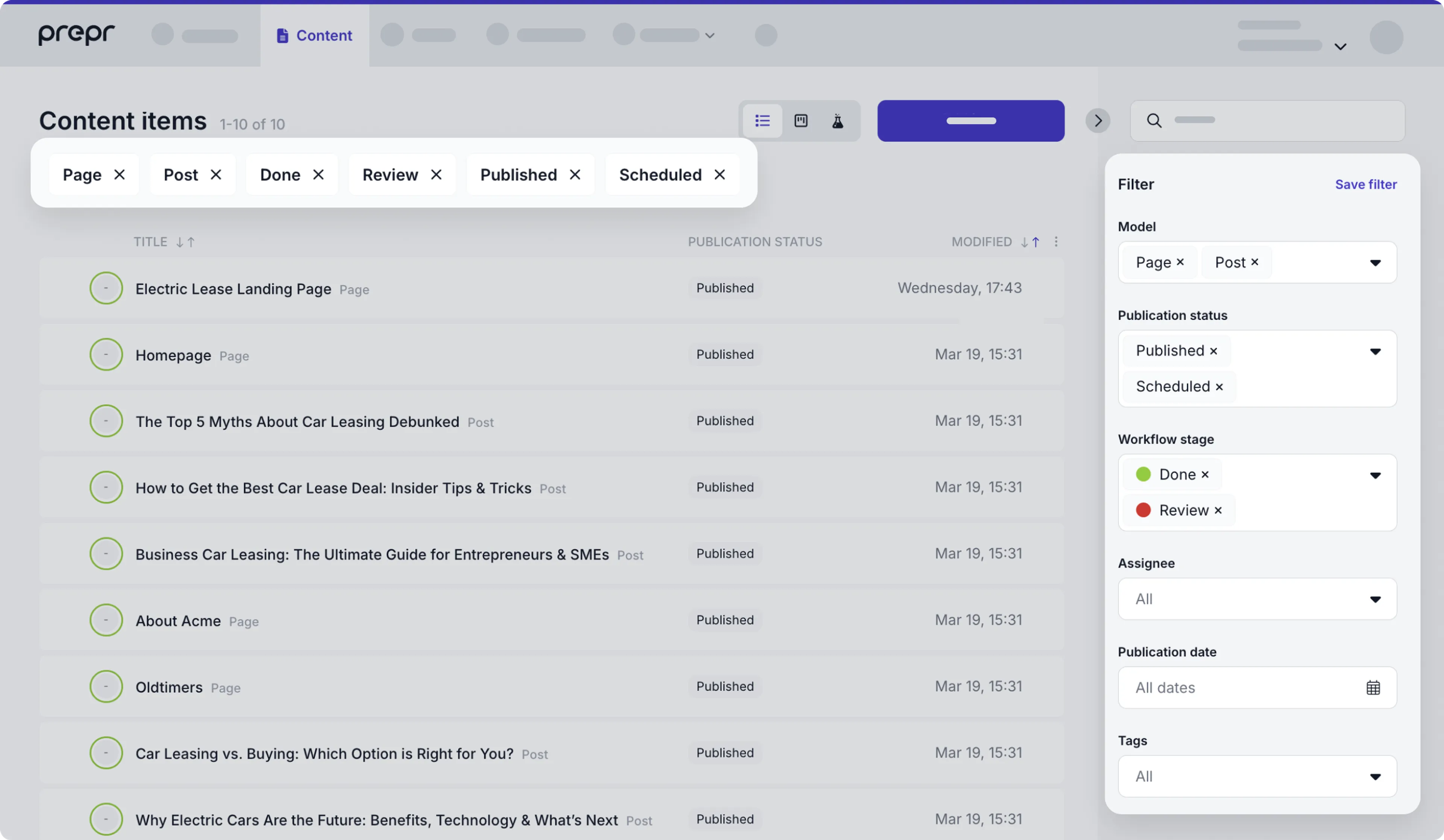
This update ensures efficient content searches.
Check out the content management docs for more details on content filters.
Help text as field value placeholder
April 7th, 2025
In addition to the help text line above a field or as a tooltip next to a field name, we’ve added a new way to display help texts: directly in the field value as a placeholder. Now, you can see some help text directly in the Text, Slug, Tags, Number, Location, and Social fields.
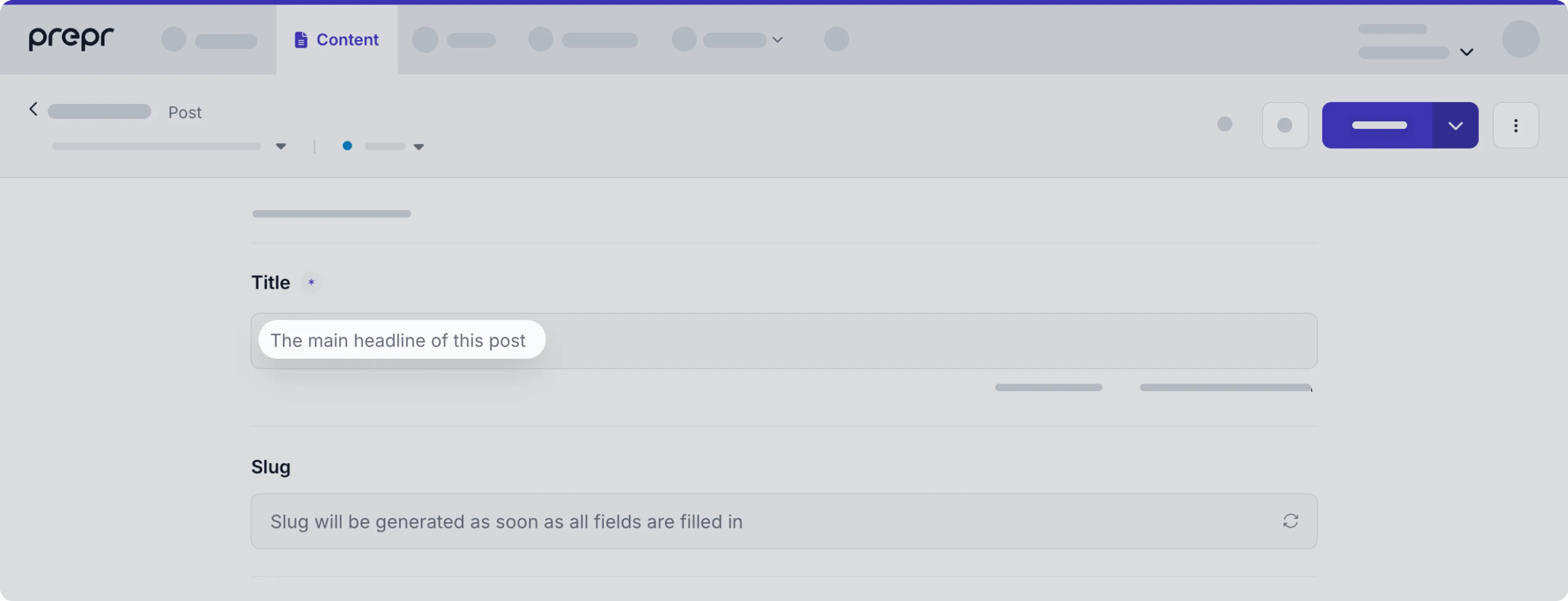
This gives you clear instructions while keeping the interface clean and intuitive. With this update, editor guidance is always in the right place without cluttering the design.
Check out the setup details in the field appearance settings.
New Help text field for better editor guidance
April 2nd, 2025
We’re happy to bring you improved guidance while editing content with the new Help text field. A developer can add this field to any model or component to give you more visible and structured instructions.
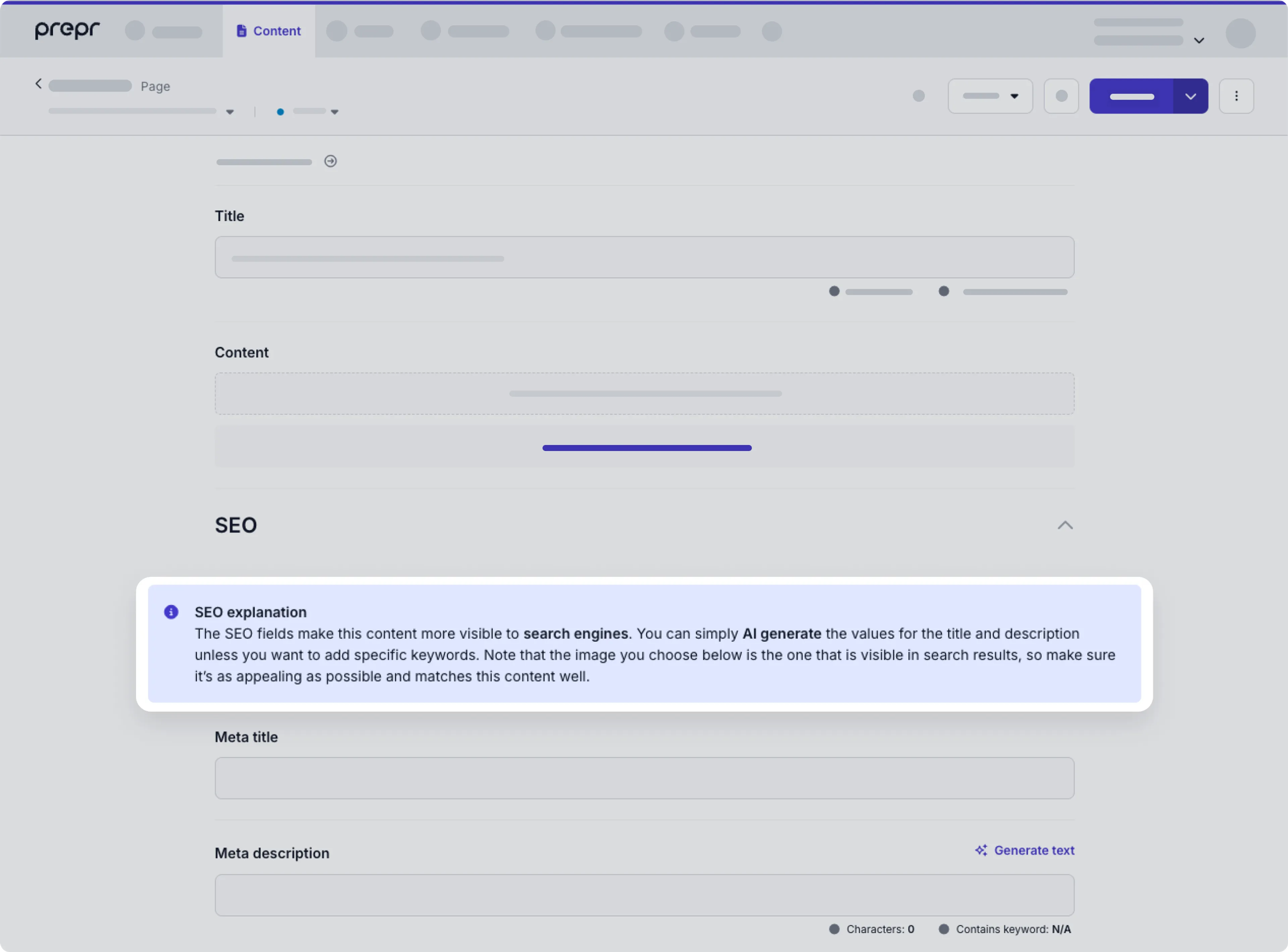
With the flexibility of this feature, it ensures smoother and more efficient content management.
For more details, check out the Help text field setup.
Removal of after and before parameters in REST Mutation API index requests
March 28th, 2025
We’re simplifying our REST Mutation API pagination parameters. Starting July 1, 2025, the following changes will take effect in all index requests:
- The
afterandbeforeresponse parameters will be removed. - The
afterrequest parameter (used to skip pagination items) will also be removed.
If you’re currently using the after/before parameters, we recommend updating your integration to use the skip parameter instead.
This update improves consistency across our APIs.
Introducing conditional fields
March 27th, 2025
Introducing conditional fields - a huge step toward easier and more efficient content management. With conditional fields you can now choose to show or hide fields or sections depending on another field’s value.
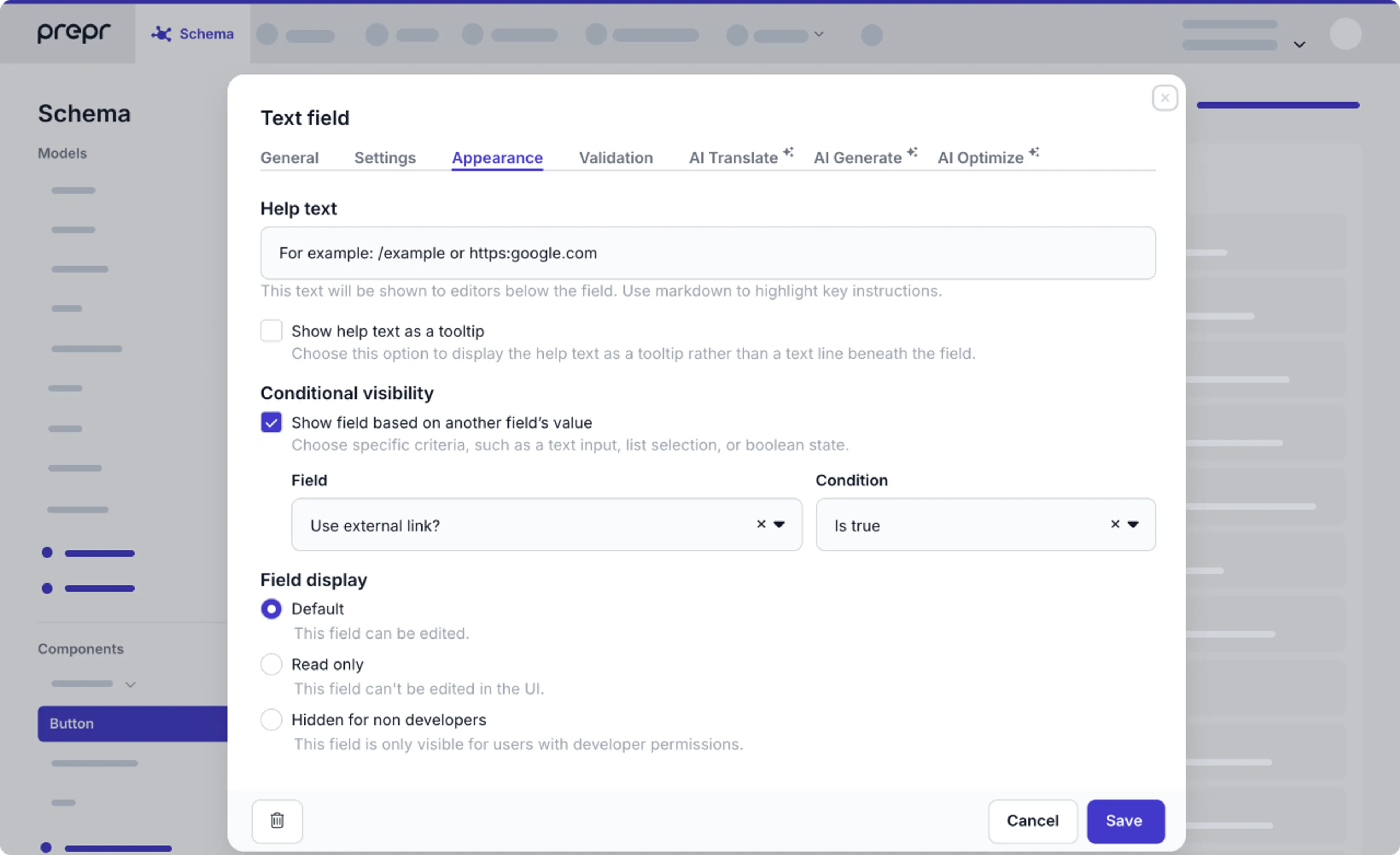
This feature simplifies the editing experience with a cleaner interface without unnecessary fields. For example, to show either the external URL field or an internal link field in the content item and not both.

Check out the field settings doc for more details.
New in Visual Editing: Segment & A/B Test preview
March 25th, 2025
We’ve enhanced Visual Editing with new Segment and A/B test variant switches. These switches allow you to preview personalized content for specific segments and each A/B test variant before publishing the content item. By previewing content for specific groups of targeted visitors, you have more control and confidence in your content adjustments.
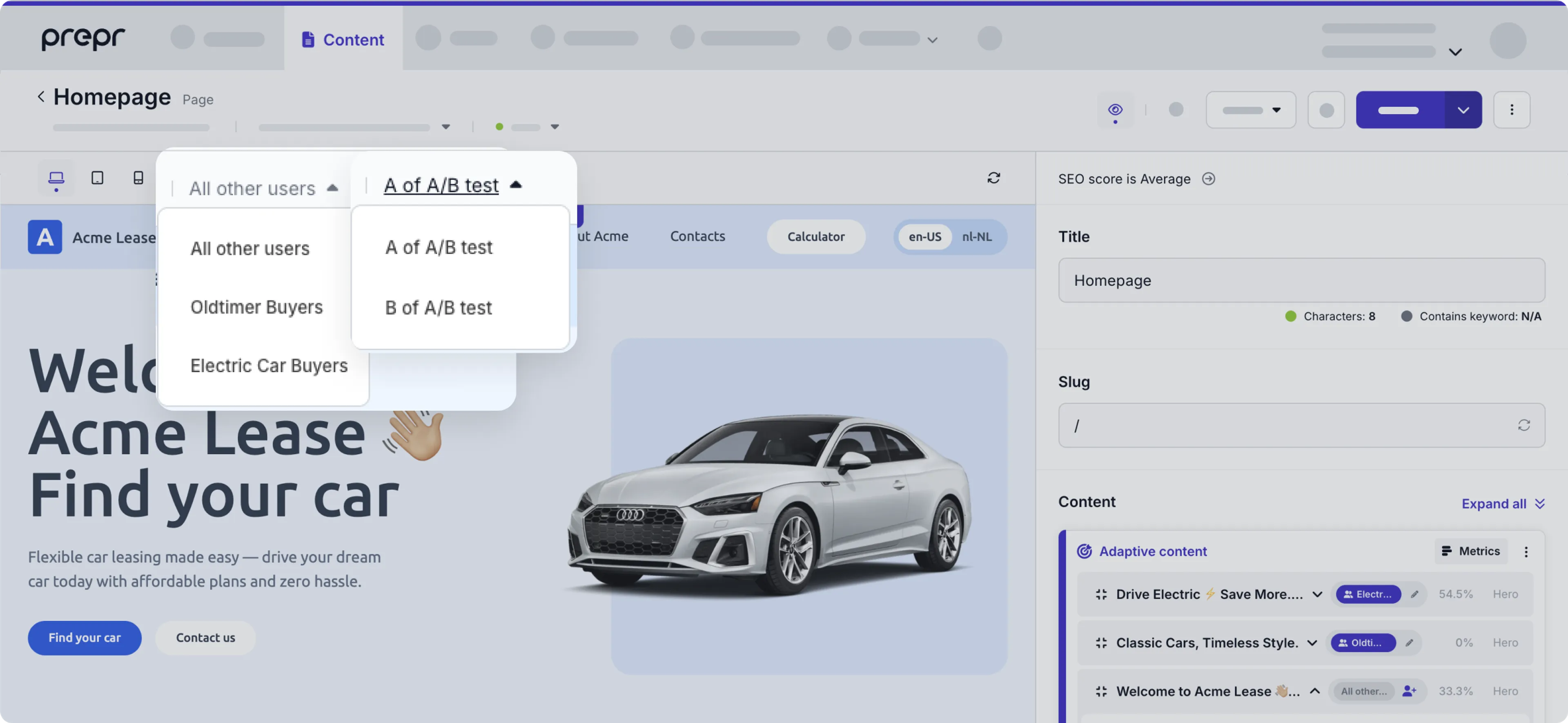
The Segment and A/B test switches are available automatically if your front end uses the latest Prepr Next.js package. If not, check out the setup details to enable the adaptive preview for any other front-end framework.
Managing content with shortcut keys
March 17th, 2025
In line with the Content UX improvements released last week, we’re happy to introduce new shortcut keys to help you manage your content faster and more efficiently.
Now, with just a couple of keystrokes, you can quickly select all content items with Ctrl + A, add an item with Ctrl + I, publish a content item with Ctrl + P, and more - giving you greater control and saving you valuable time.
For more details, check out the managing content items docs.
Improved rescheduling of content items
March 13th, 2025
Based on your feedback on the recent Content UX updates, we’ve improved how rescheduling works for published content — it now updates the First Published at date and time to the new date and time you choose when you reschedule the content item.

By rescheduling a published content item, you can choose how to order the content items in the front end when they’re ordered by the First Published at date and time. This gives you more flexibility and allows you better control over the order of published content.
Check out the content management docs for more details.
Introducing Visual Editing
March 11th, 2025
Visual Editing is finally here! This new feature allows you to view content changes to your web pages in real-time with a convenient side-by-side view in the Prepr Content page.

This means, you can instantly see how your edits affect the page layout and content, reducing the need to switch between tabs to check your updates. Visual Editing gives you instant, crystal-clear insight into your changes, making your editing process a lot faster, effortlessly smooth, and a great deal more intuitive.
Check out the visual editing setup and the content management docs for more details.
Improved UX for content references
March 11th, 2025
In response to your feedback, we’ve improved the UX for content references when editing a content item.
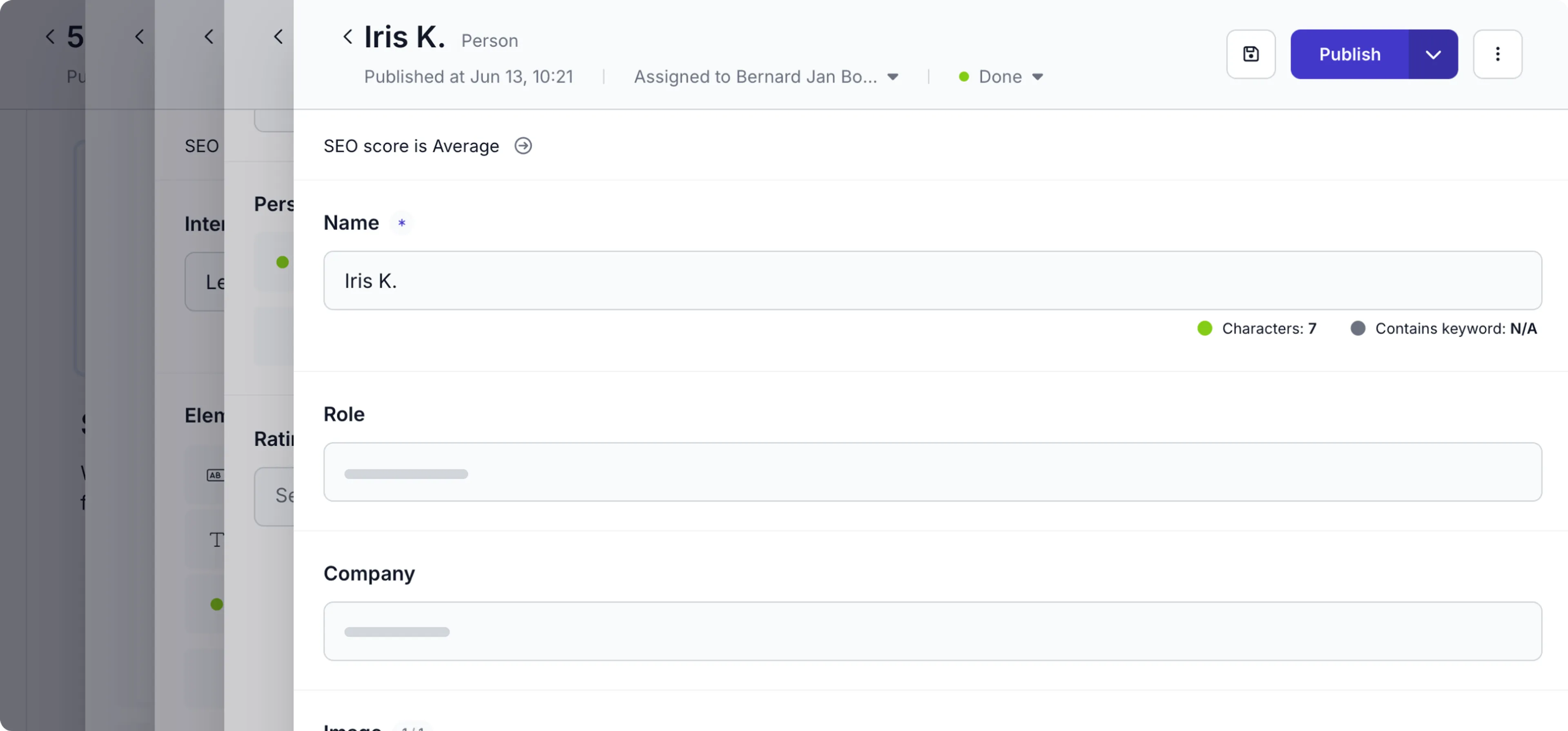
With the updated overlays, now you always know where you are in deeply nested items. Together with a cleaner interface, this clarity minimizes errors and gives you full control over your content, making content updates seamless and stress-free.
Check out the content reference doc for more details.
Updated content item UX
March 11th, 2025
To support the Visual Editing feature, we’ve updated the Content Item detail page with a cleaner, more intuitive interface. Primary content editing actions have been moved to the top. You’ll also notice that the default publish action has been updated to match your preference.
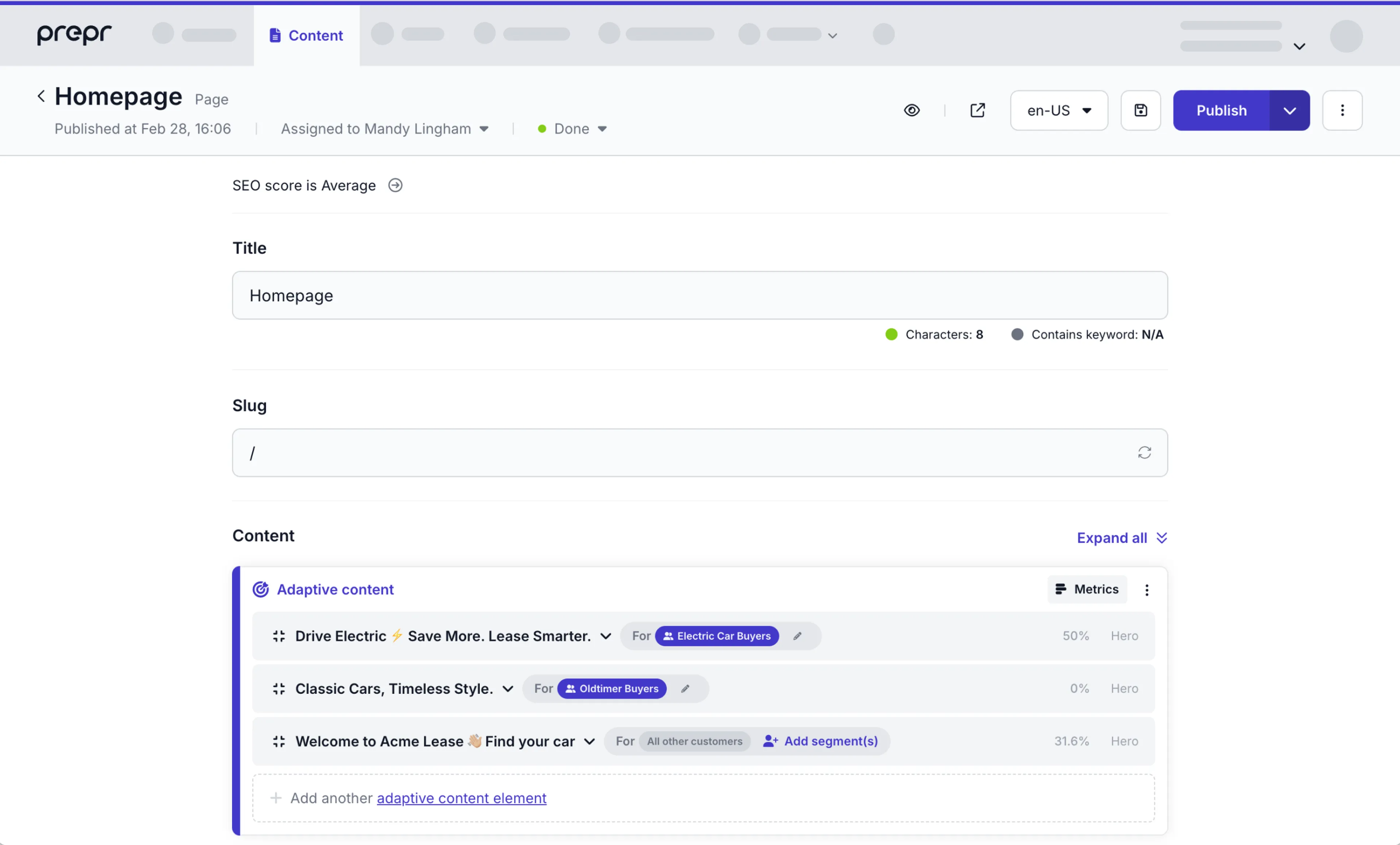
We trust this update gives you a more streamlined experience when editing content.
Check out the content management docs for more details.
Deploying to Vercel directly from Prepr
March 10th, 2025
As you’ve requested, you can now deploy your website directly from Prepr. Simply click the new Build and deploy button to deploy your website to Vercel and the live website is updated with your latest published content as soon as you need it.
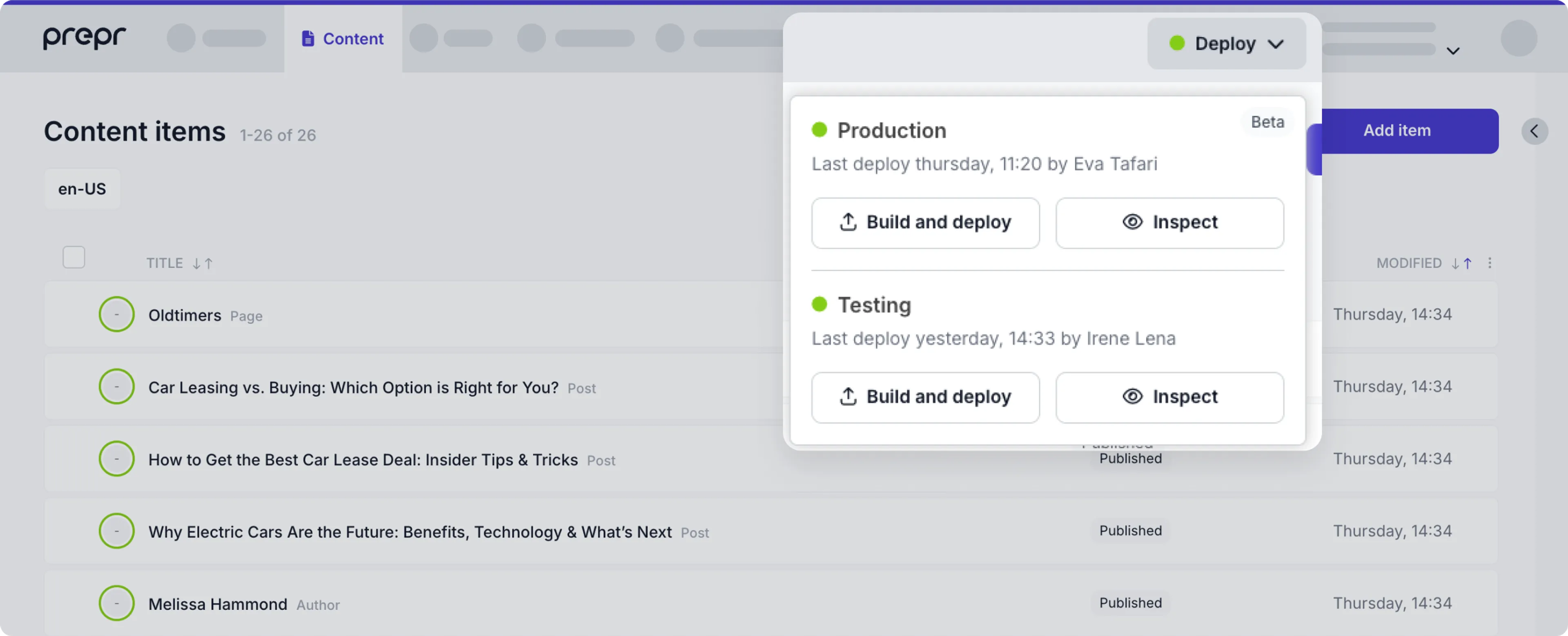
This new feature is especially useful for statically built and deployed websites where you don’t see your content changes immediately after publishing. This way, you have more control over the website content without needing to switch over to Vercel or to contact developers to trigger a new deployment for you.
Check out the Vercel integration doc for the setup details.
Improved video upload feedback
March 5th, 2025
We’ve improved the video upload experience in Prepr by adding a real-time progress indicator, showing the exact percentage of transcoding completion.
This makes it easier to track the status of larger video uploads.
Additionally, we’ve introduced a Failed to Transcode error message, providing clear feedback if an issue occurs during processing.
Check out the assets doc for more details.
Improved content item creation
March 3rd, 2025
Based on your feedback on adding content items, we’ve refined the Add item action for usability. Previously, when adding an item, you could select from all models when creating new content items.
From now on, the model selection window excludes single-item models if their content item has been created. This update declutters the model selection, making content management more intuitive and efficient.
Check out the content management doc for more details.
Setting an image focal point
February 26th, 2025
As requested, we’ve added a feature that allows you to set a focal point when adding or editing an image in a content item.

To enable the option to set an image focal point instead of the option to crop the image, check out the asset field settings for more details.
By setting a focal point for an image, you ensure the key parts of the image remains visible (such as a person’s face or a product), even when resized for different screen sizes. This feature means your front end delivers better visual presentation, and improves user experience.
Check out the image docs for more details.
New Marketer role
February 24th, 2025
With the new Marketer role, you can add your marketing team members to Prepr. The Marketer role is designed for users who manage and optimize audience segmentation within Prepr. This role has the same permissions as the existing Editor role, allowing users to create, edit, and manage content. However, marketers also have access to the Segments feature, enabling them to define and view audience segments.
Check out the roles and permissions doc for more details.
Introducing the Zapier integration
February 19th, 2025
We set up Prepr’s Zapier integration as part of our efforts to continually improve your experience with integrating to Prepr CMS. This new integration enables automated tagging of customer profiles and provides an external trigger for event tracking in Prepr. With Zapier you can choose any listed app to send data to Prepr automatically.
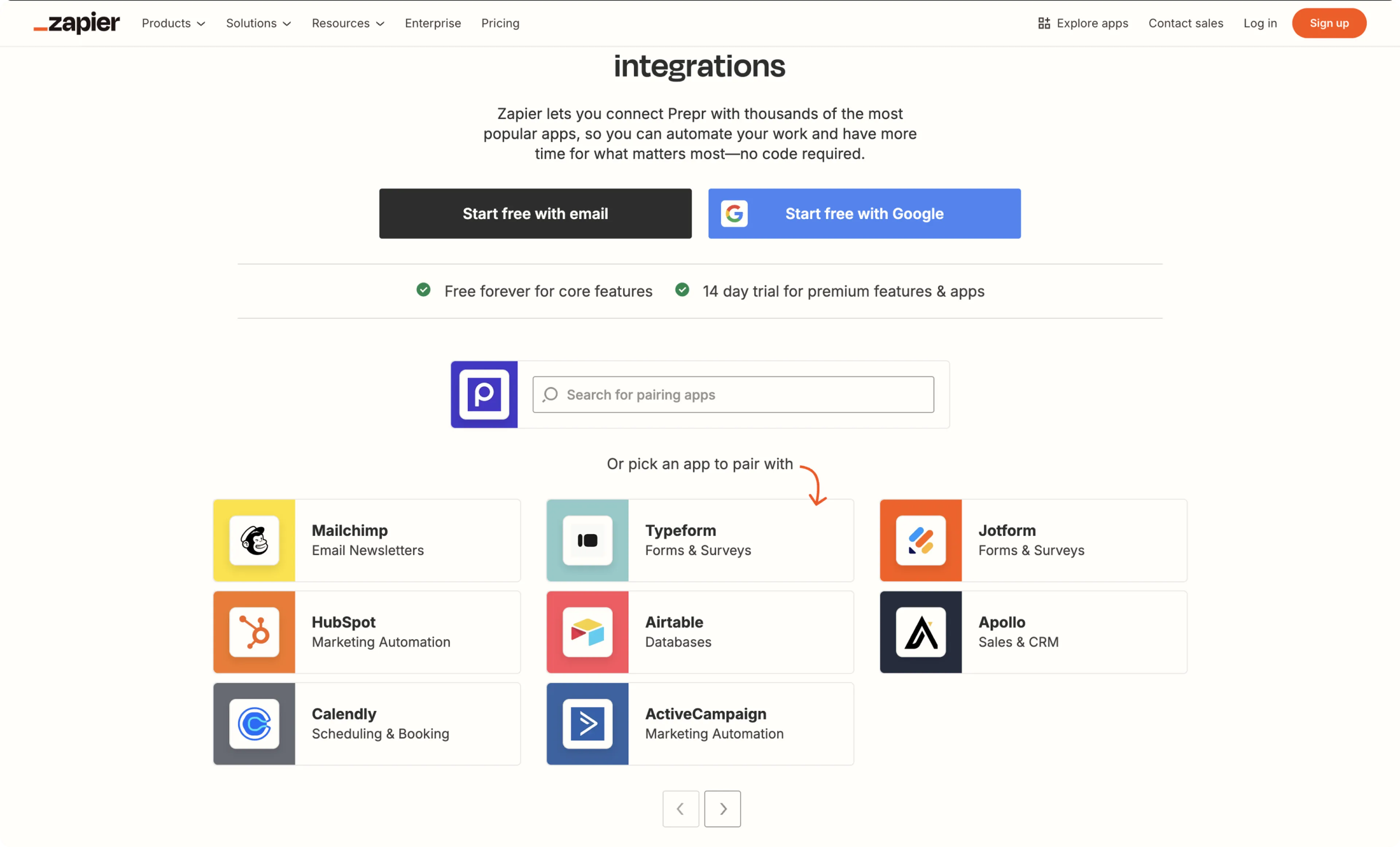
Think about the case where you want to add a tag with the industry of a known customer in Prepr when they request a demo through a HubSpot form.
Previously, you had to manually export and import this data to Prepr or create a custom API integration. Now you can easily automate this process with Zapier by simply choosing the listed app to pair such as HubSpot, a trigger like a New Form Submission (for example, when there’s a demo request), and the Prepr action of Tag a Customer Profile.
This workflow in Zapier automatically triggers Prepr to save the customer data you choose in the tag of a known customer profile. This means you have an easy, automated segmentation setup without development effort, leading to better personalization.
Check out the Zapier integrations doc for more details.
Introducing support for semantic versioning (SemVer)
February 11th, 2025
As requested we’ve added support for semantic versioning in the HTTP header context in segments. This means you can create conditions like in the example image below.

Semantic versioning gives you more flexibility and precision with your segmentation in the HTTP header context. You can confidently enforce version requirements, preventing unwanted or inconsistent content when segmenting your customers.
Check out the segments doc for more details.
Bulk publishing content items
February 11th, 2025
We’re very happy to bring you new options to quickly publish or unpublish multiple items simultaneously. With these new actions you can choose to publish or unpublish your chosen content items immediately or to schedule these actions for a future date.

These new features help you efficiently release and manage batches of content items, such as campaigns or updates that span several pieces of content, saving time and reducing manual effort. No more repetitive manual tasks means that you can manage your content faster, freeing up time to focus on strategy and creativity.
Check out the managing content docs for more details.
Introducing the Prepr Next.js package
February 5th, 2025
We’re excited to introduce the Prepr Next.js package, a powerful toolkit to streamline your personalization and A/B testing implementation. Now you can integrate Prepr’s features into your Next.js front end faster and more efficiently with the following features:
- It provides API request headers for the following values:
- Each visitor’s customer ID. You need this API request header,
Prepr-Customer-Id, when you query adaptive content and content with A/B testing. - Any UTM parameters, if applicable. This is useful to identify customers who enter your website through a social media campaign, for example.
- HubSpot cookie, if it exists. This is useful for identifying customers who are tracked in HubSpot as a lead, for example.
- The visitor’s IP address. This is useful for localization.
- Each visitor’s customer ID. You need this API request header,
-
The Adaptive Preview Bar. When you include this component in your front end, you allow content editors to effortlessly toggle between A/B test variants and personalized experiences for validation.

Check out the Prepr Next.js package guide or visit the GitHub repository directly for the step-by-step instructions to install and use the package.
Tracking customers by their email address
February 5th, 2025
You can now track a visitor’s email address and store it in their customer profile in Prepr. You can do this by triggering a simple javascript in your front end when the customer provides their email address in the web app.
prepr('event', 'Email', '[email protected]');Check out the tracking events doc for more details.
This feature makes it easier to track customer interactions in other platforms you might be using, enabling more insights.
Improved Publication date filter for the content item list
January 15th, 2025
We’re happy to bring you an improved publication date filter when you view the content items list. The previously called Published on filter is now called Publication date for greater clarity. This filter is based on the content item Publication date instead of the previous Publish on dates. We’ve also updated the date selection for this filter to support future dates, allowing you to easily find not only past published content items, but also scheduled content items.
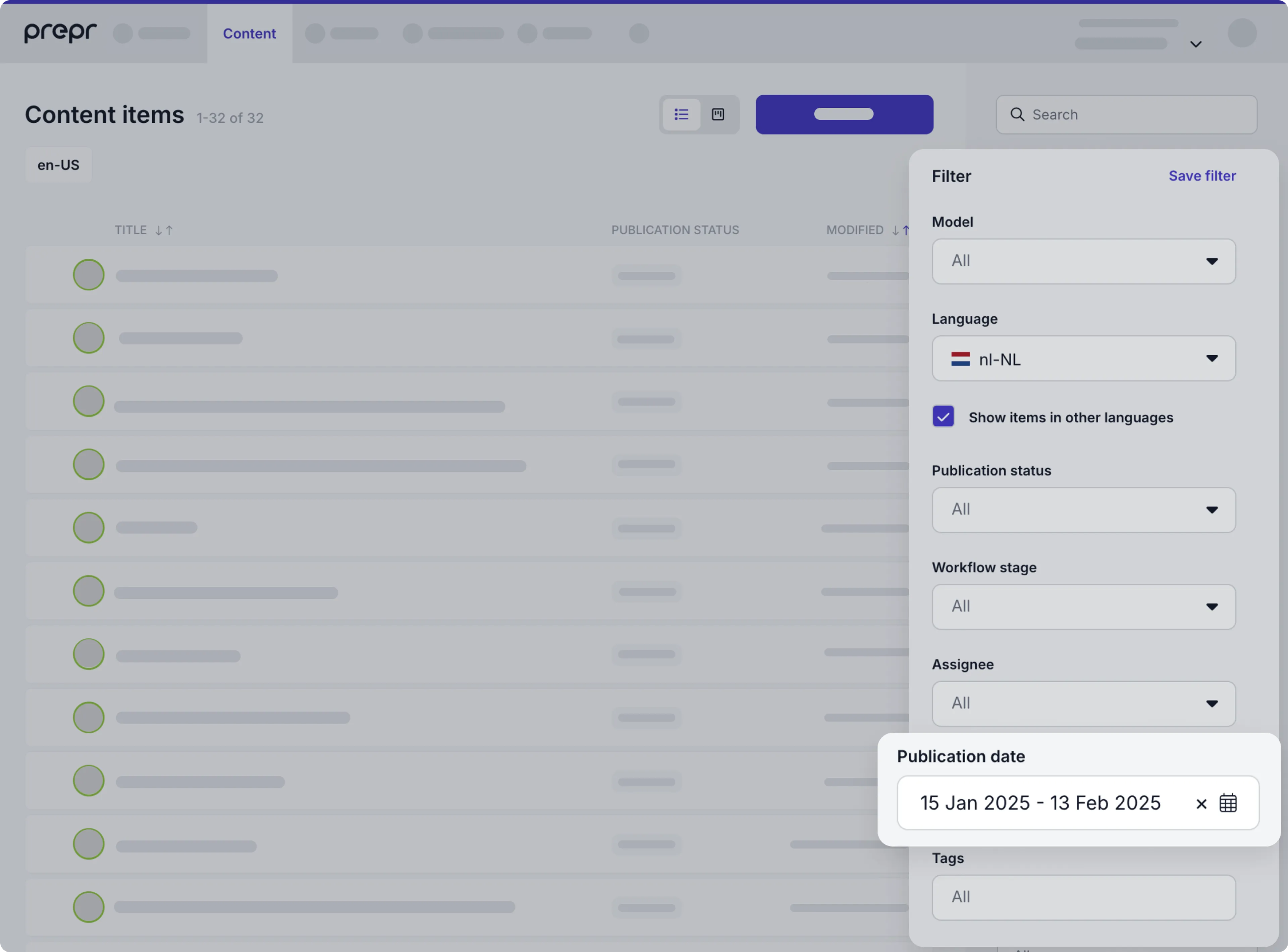
For more details on filtering content items, check out the managing content doc.
New info text to indicate null boolean values
January 14th, 2025
We’ve added info text to indicate when a boolean value is null in a content item. This info text indicates that you need to explicitly set a value for this field and save the content item.
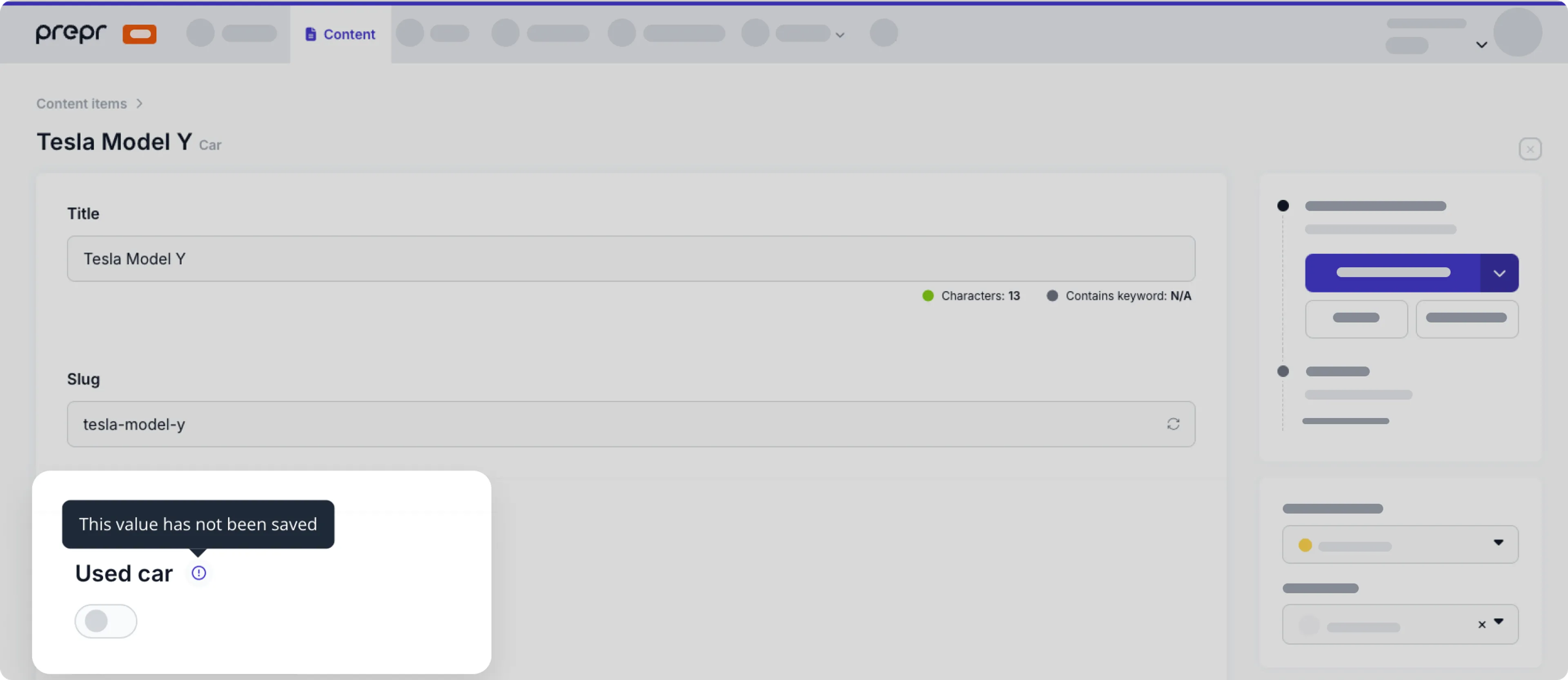
Content items with null boolean values will not be included in filters based on this boolean field.
Sync your schema with Azure DevOps
January 13th, 2025
We’re happy to announce that we’ve added another option to the Schema sync feature in Prepr. You can now choose to sync a schema using Azure DevOps. If your preferred tool for CI/CD workflows and source control management is Azure DevOps, you can include the sync process to manage schema updates in this single platform.
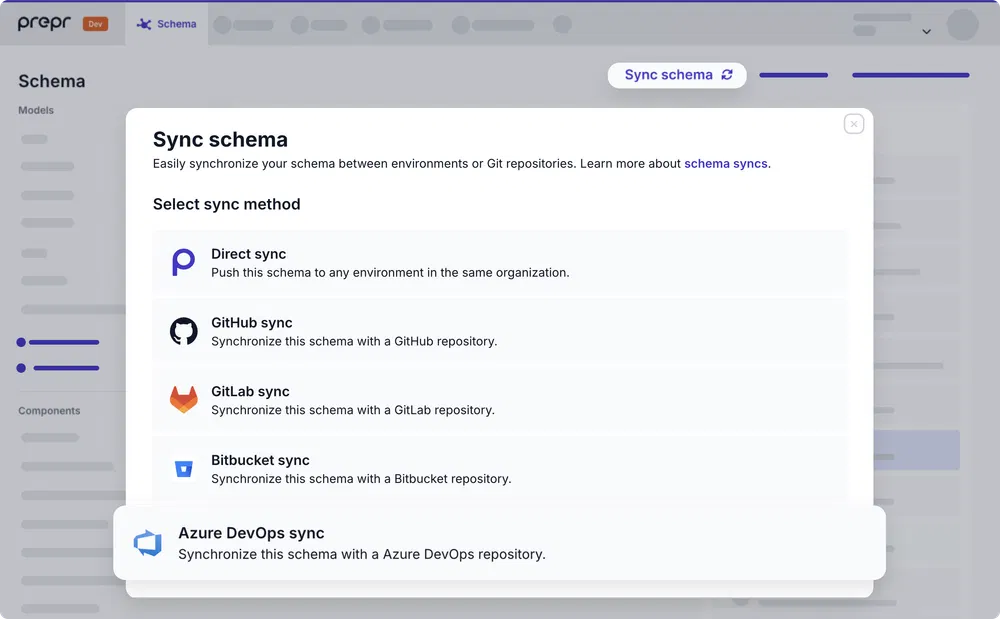
Check out the step-by-step guide in the Azure DevOps schema sync doc.
Support for Stories in the REST API has been fully removed
January 13th, 2025
Following the deprecation of Stories in Prepr UI in January 2024, we have now completed the removal process by eliminating all related functionality from our REST API. We trust that this update has very limited impact, if at all, but please ensure your integrations are updated, if needed. Contact Prepr support if you have any questions.
Duplicate models, components and enumerations instantly
January 7th, 2025
We’re happy to bring you yet another feature you’ve requested - The option to duplicate models, components, and enumerations.
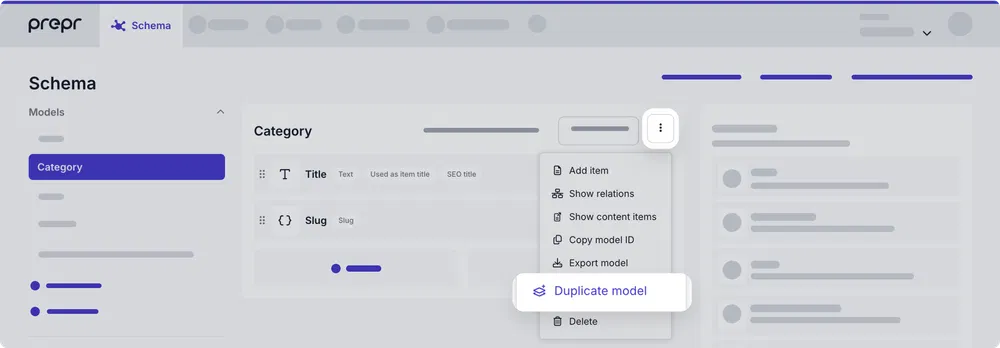
Quickly create similar models, components or enumerations without the need to manually add each field. This saves you time and reduces errors by duplicating existing structures, streamlining your workflow for faster content modeling and delivery.
For more details, check out the content modeling docs.
Improved image naming and URL structure
January 6th, 2025
We’re pleased to let you know that we’ve improved how image files are named and how their URLs are set in Prepr CMS.
Now when you upload new images, they retain their original file name. The optimized URL for each image also includes a cleaner prefix after the hostname, providing a more structured and consistent format for better organization and readability.
Example
Previous URL structure: https://example.stream.prepr.io/{format_options}/695a4d1eiaom-sustainability.png
New URL structure: https://example.stream.prepr.io/695a4d1eiaom/{format_options}/sustainability.png
These changes make it easier for you to manage these assets, better visibility, and they align with SEO best practices.
This update only applies to newly uploaded images. Existing images will retain their current file names and URLs.
Check out the Editing assets doc for more details on image fields.